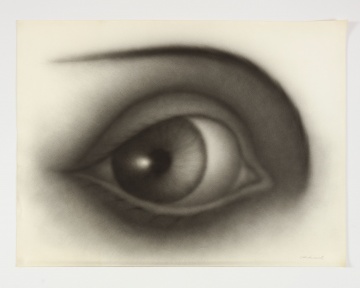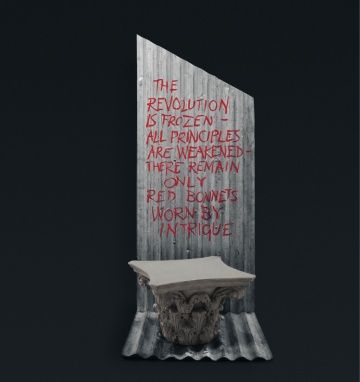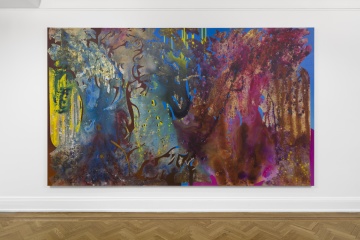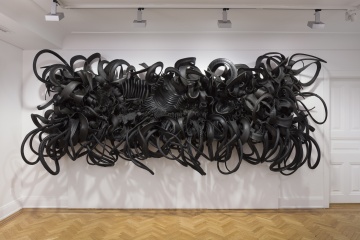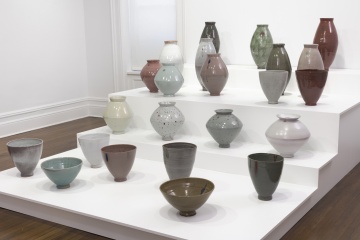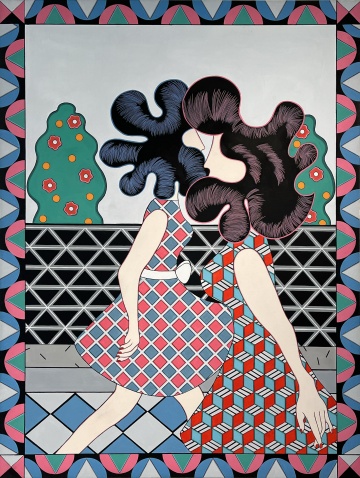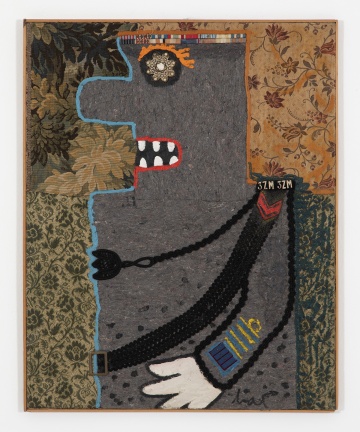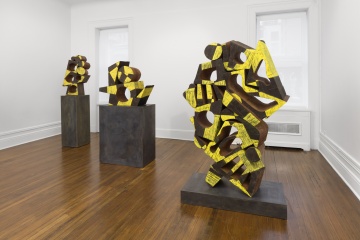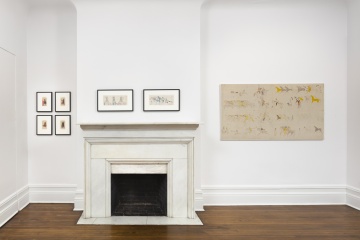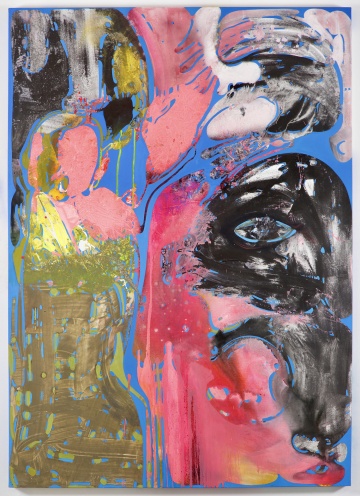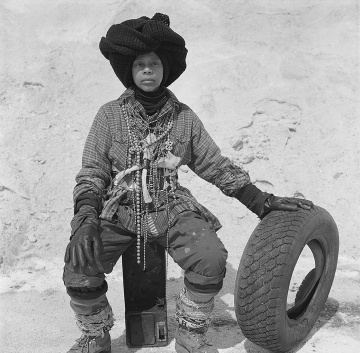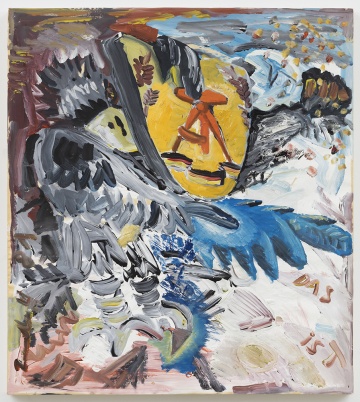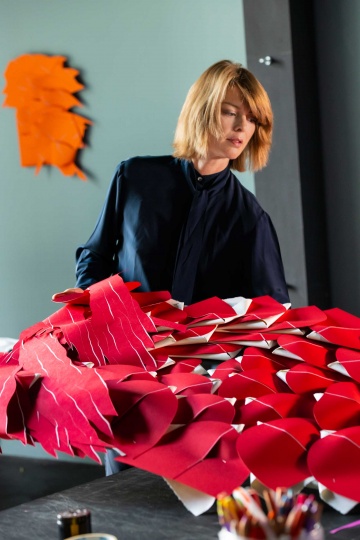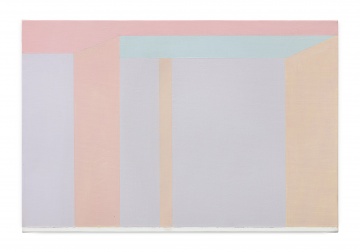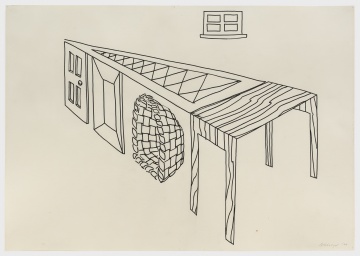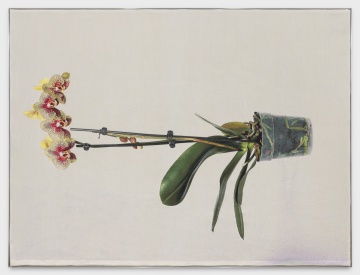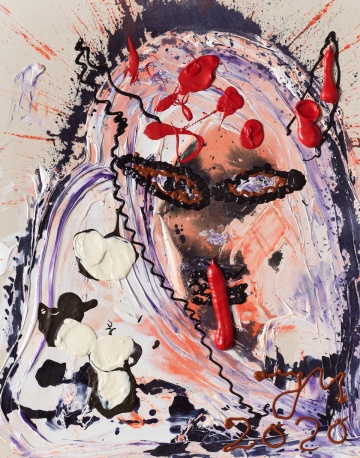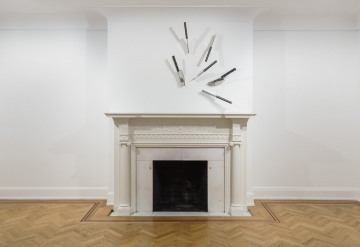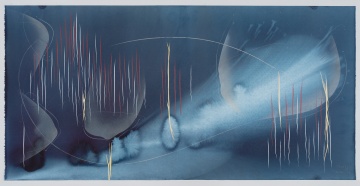David Nolan Gallery
24 East 81st Street
New York, NY 10028
212 925 6190
New York, NY 10028
212 925 6190
Founded in 1987 in SoHo, David Nolan Gallery specializes in modern and contemporary works by an array of international artists, from different generations and cultures, working in a variety of media. The gallery’s original mission was to showcase contemporary works on paper along with painting and sculptures by American and European artists, and to produce monographs alongside tightly curated historical exhibitions. The first solo show at the gallery – an exhibition of early drawings by Sigmar Polke - was followed by presentations of now-canonical German artists, including Georg Baselitz, Martin Kippenberger, Dieter Roth, Gerhard Richter, Hermann Nitsch, Rosemarie Trockel and Albert Oehlen. In this same period, the gallery began showing works by major American artists including William Copley, Carroll Dunham, Fred Sandback, Al Taylor and Barry Le Va.
In 1993, David Nolan Gallery had its first exhibition with Richard Artschwager, which was succeeded the following year with a show of work by Scottish artist Ian Hamilton Finlay. In the late 1990s, another two key American artists were introduced to the program, Jim Nutt and Peter Saul. Further growth was marked by the inclusion of New York-based artists Mel Kendrick and Steve DiBenedetto in the mid-2000s, at a time when the gallery also began working more closely with the Estate of George Grosz.
In 2007, David Nolan Gallery mounted an important survey of contemporary Romanian art, which included work by Adrian Ghenie and Gabriela Vanga, alongside Ciprian Mureşan and Şerban Savu, both of whom continue to work with the gallery. The following year saw the gallery’s expansion and relocation to its new location in Chelsea, a move that was inaugurated by a major Artschwager exhibition along with the addition of gallery artists Julia Fish, David Hartt, Jonathan Meese, Wardell Milan, and Jorinde Voigt in the coming decade.
David Nolan Gallery has continued to build on its reputation of showing leading international artists, adding Dorothea Rockburne in 2020, and announcing its newest location on the Upper East Side, inaugurated in Spring 2020 with an exhibition of new works by Jorinde Voigt and the gallery's fourteenth solo show of Barry Le Va. In 2021, the Estate of Rodrigo Moynihan joined the gallery, followed by Brazilian painter Paulo Pasta, whose first show at David Nolan Gallery marked the artist's first solo presentation in all North America. In 2022, American artist Chakaia Booker joined the program, followed by Iraqi-American painter Vian Sora in 2023.
Artists Represented:
The Estate of Rodolfo Abularach
The Estate of Richard ArtschwagerEnrico Baj
Chakaia Booker
Chakaia Booker
The Estate of Ian Hamilton Finlay
Julia Fish
The Estate of George Grosz
David Hartt
Mel Kendrick
The Estate of Barry Le Va
Julia Fish
The Estate of George Grosz
David Hartt
Mel Kendrick
The Estate of Barry Le Va
Young-Jae Lee
Jonathan Meese
The Estate of Rodrigo Moynihan
Ciprian Mureşan
Jim Nutt
Ciprian Mureşan
Jim Nutt
Paulo Pasta
Christina Ramberg
Dorothea Rockburne
Eugen Schönebeck
Christina Ramberg
Dorothea Rockburne
Eugen Schönebeck
Vian Sora
Jorinde Voigt
Jorinde Voigt
Ray Yoshida
Works Available By:
Georg Baselitz
Georg Baselitz
Hans Bellmer
James Bishop
William Copley
R. Crumb
Steve DiBenedetto
Deborah Druick
Carroll Dunham
Mona Hatoum
Louis I. Kahn
Martin Kippenberger
Martin Kippenberger
Albert Oehlen
A.R. Penck
Dieter Roth
Fred Sandback
Peter Saul
Al Taylor
Rosemarie Trockel
Andy Warhol
Andy Warhol
Franz West
Rodolfo Abularach
RODOLFO ABULARACH: A Cosmic Vision
June 12, 2025 - July 31, 2025
David Nolan Gallery is delighted to announce its first solo show of one of Latin America’s most significant yet under recognized artists, Rodolfo Abularach (Guatemalan, 1933-2020). This is the first full-scale gallery exhibition in New York to explore the breath of the artist’s work.
Rodolfo Abularach: A Cosmic Vision is a bicoastal collaboration with Marc Selwyn Fine Art, Beverly Hills, where a simultaneous presentation of Abularach’s work will be on view from June 26 through August 9. Along with these concurrent exhibitions, David Nolan Gallery and Marc Selwyn Fine Art are pleased to announce publication of the first major monograph dedicated to the artist, for which art historian, writer, and curator Gavin Delahunty, artist and curator Gabriel Rodríguez Pellecer, and curator Rudy F. Weissenberg have contributed insightful essays.
Throughout his over six-decade-long career, Abularach created a fascinating spiritual world filled with images of planetary forms, mandalas, and earthly and psychological portals. His most famous subject was the eye, which he saw as a window into the soul. His interest in the mysteries of the earth also led him to depict volcanoes, emblems of the artist’s Guatemalan homeland and ancient history. Abularach mastered and explored a variety of styles, from hyperrealistic to abstract, monochrome to multicolored, esoteric to surreal. He was known for his virtuosity in multiple media, including painting, drawing, and printmaking.
The exhibitions at David Nolan Gallery and Marc Selwyn Fine Art will highlight the major themes Abularach explored throughout his career. A selected group of works on paper and paintings will illustrate the artist’s evolution from enigmatic circular forms and abstract mandalas to the human eye in all its possible variations, and dramatic depictions of volcanic eruptions, inspired by Dante’s Inferno and Popol Vuh, the sacred book of the Quiché Maya People.
A practitioner of Tantric Buddhism and meditation, Abularach was equally influenced by the Mayan traditions and cosmic vision (2 Círculos - Armonía y Contraste, 1965 and Aparición - Centro No. 1, 1971). His compositions from the 1960s were innovative abstractions informed by Mayan stelae, where the artist used light as a vehicle to create space where forms could float.
"Estela: I took this title from the vertical stone sculptures that the Mayans made. For them, it was a way of recording the most important events, such as astronomical dates. In my drawing, it is a luminous frontal and vertical composition, like an apparition in a mystical, poetic sense. It is like a light imprisoned. The technique I used allowed for a luminous impression. It is also like a luminous apparition through a doorway—the forms float in space, almost suspended by the light. Above, a circle—almost a frontal eye or a black disk, like an eclipse.”
– Rodolfo Abularach
From these abstracted landscapes, Abularach concentrated on an orb that eventually took the form of a human eye (Ojo Centro Blanco No. 7, 1970). He once described his “eyes” as “a symbol of liberation, ascension, and peace. Forms emerging from darkness into light.” The eye served as an icon for a multi-dimensional exploration of inner and outer worlds, which Abularach rendered in his spectacular depictions that varied from realistic to geometric, abstract, uncanny, and mystical.
Abularach made his ink drawings with a tightly woven texture, an exquisite cross-hatching he achieved with a pen, giving the illusion of sfumato. These works convey the artist’s meditative state; they were drawn mainly at night and seem to reflect the glittering light of a candle (Circe No. 3, 1969 and Olimpia, 1979).
In various mythologies, eyes are often symbols of celestial or cosmic deities; in religions such as Hinduism and Buddhism, the third eye represents the ability to perceive beyond the limitations of the physical senses and access higher realms of consciousness. Abularach moved from the terrestrial to the celestial in his Cósmico No. 3 – Aleluya (1977) where the iris of an outsized eye reflects concentric cloud formations that float around a dense black aperture. In this eye of the sun, with the moon as a pupil forming an eclipse, the artist explored the concept of the “eye as a universe” and treated the human eye as a miniature representation of the vast cosmos.
Like the eye, the volcano – another energy portal – came to Abularach from an extraordinarily rich iconographic and literary tradition. It is hard to tell if what we see in his work are the volcanoes of Guatemala or the textures of the artist’s imagination (Noche, 1992). Regardless of the time they were made, Abularach’s mandalas, eclipses, volcanic eruptions, and eyes were all shaped and intertwined by light, fire and heat.
Abularach was a classic, a modern, geometric painter; a figurative painter; but above all, he is unclassifiable. He communicated with the firmament and discovered the star we all carry in our faces: the eye. That eye which, when the eyelid is closed, is the entrance to the inner world… There is a unique zeitgeist in Abularach’s paintings—a revisitation of Western and Mesoamerican myths blended with an allusion to Eastern practices, such as meditation, and Western psychedelia. What he produced would levitate and transcend any territory and time period. His works hypnotize; they capture our sight like a pendulum.
- Gabriel Rodríguez Pellecer, “Cosmic Abularach: Portrait of the Artist as a Mystic,” 2025
His work fluidly intertwines Mesoamerican symbolism, Renaissance precision, and Surrealist anthropomorphism, in addition to expressing spiritual and metaphysical ideals… Abularach once described his “eye” as a symbol of ascension and liberation—a physical organ that nevertheless has the ability to transcend the limits of the human body. Visionary and omniscient, Abularach’s eyes survey vast swathes of art history and visual culture, condensing the artist’s extraordinarily rich range of references into each keenly focused image.
- Gavin Delahunty, “An Ocular Imagination,” 2025
Biography
Born in Guatemala City in 1933, Rodolfo Abularach showed remarkable draftsmanship from a young age. In 1946, he began his formal training at the Escuela Nacional de Artes Plásticas, then moved on to the Faculty of Architecture at the Universidad de San Carlos de Guatemala and Pasadena City College in California. Between 1955 and 1957, he was hired by the Museo Nacional de Arqueología y Etnología to draw pre-Columbian masks and musical instruments from the museum’s collection. It was then that Abularach began looking to Mayan forms as inspiration for modernist compositions with the encouragement of the influential Guatemalan artist Carlos Mérida.
In 1958, while teaching drawing and painting at the Escuela Nacional de Artes Plásticas, Abularach earned a scholarship from Guatemala’s Directorate of Fine Arts to study at the Art Students League in New York. He remained in New York for 40 years, initially supported by scholarships, including two Guggenheim Fellowships in 1959 and 1960. In the 1960s, Abularach began exploring the human eye, which became an iconic motif of his. By the end of 1960, his work had been exhibited at the Art Institute of Chicago, the 5th São Paulo Art Biennial, the Milwaukee Art Museum, and the Museum of Modern Art, New York, which acquired his work for its permanent collection. In 1998, the artist returned to Guatemala City, where he remained until his death in 2020.
Abularach’s work is held in an extraordinary number of major collections and institutions worldwide, including The Metropolitan Museum of Art, Museum of Modern Art, El Museo del Barrio, and Brooklyn Museum in New York; Smithsonian American Art Museum and Art Museum of the Americas in Washington, D.C.; Art Institute of Chicago; High Museum of Art in Atlanta, Georgia; San Francisco Museum of Modern Art and Los Angeles County Museum of Art in California; Museum of Modern Art in Bogotá, Colombia; Museum of Modern Art in Guatemala City; Museum of Contemporary Art in São Paulo, Brazil; National Gallery of Denmark (SMK) in Copenhagen; and Museum of Art and History in Geneva, Switzerland, among others.
Ian Hamilton Finlay
IAN HAMILTON FINLAY: Fragments
May 8, 2025 - June 7, 2025
David Nolan Gallery is pleased and greatly honored to present an exhibition marking the centennial of the birth of Ian Hamilton Finlay (1925–2006). One of Scotland’s most celebrated artists, poets, and philosophers, Finlay revitalized the classical tradition in a body of work that spans multiple disciplines, emphasizing the enduring power of the word. The gallery has proudly exhibited his works for over thirty years, and this exhibition is part of Ian Hamilton Finlay: Fragments, a major international project which includes a newly published book and eight exhibitions across the USA, England, Scotland, Germany, Switzerland, Austria, Italy, and Spain in May 2025, curated and edited by Pia Maria Simig. The exhibition at David Nolan Gallery is the only one in the Americas and is designed by Philadelphia-based, Canadian artist David Hartt.
Ian Hamilton Finlay’s Practice
Finlay’s work is difficult to classify. He collaborated with traditional craftsmen, architects and contemporary artists creating work across several disciplines. Some know him as Britain’s foremost concrete poet, pioneering the movement through Wild Hawthorn Press, which he co-founded in 1961. Others see him primarily as a gardener; his magnum opus being Little Sparta, a poetic garden in the Pentland Hills near Edinburgh. Spread over seven acres of wild, exposed moorland, and containing over 270 sculptures, Little Sparta was the focus of Finlay’s artistic dedication since his arrival at the farm with his family in the autumn of 1966 and until his death in 2006. His art lives on in museums, parks, and gardens worldwide, resisting the conventional and simplistic labels of conceptual, postmodern, or classical. Above all, Finlay considered himself a poet with much of his work hovering on the borderline between poetry and some other medium. He worked with and through poetics, by using language, materials, and moments that he created in his Garden Temple.
Drawing from philosophy, history, and mythology, Finlay spent nearly forty years developing a rigorous and intricate body of work. His concrete poetry—where the form is as important as the meaning—confronts Western cultural values, referencing the French Revolution, World War II, and classical civilizations. Beauty, violence and the sacred coalesce in his works mirroring the dissolution of ideals in contemporary politics and culture at large. Believing that the positive Western symbols had been drained of their meaning by consumerist assimilation, he turned to emblems of power and aggression—machine guns, tanks, guillotines—symbols that, unlike commercialized imagery, retained their potency. His art explores the tension between fixed ideas and shifting moods, and between culture and nature.
The Exhibition
Ian Hamilton Finlay: Fragments presents works from the late 1970s to the late 1990s, ranging across porcelain, ceramic, stone, bronze, plaster, and metal sculptures, as well as prints. Each work speaks to themes central to Finlay’s practice—poetry and wordplay, romanticized notions of the classical, the limits of interpretation, and the interweaving of religious, political, and aesthetic power.
In ROUSSEAU (Sour Vase) / A Wild Flower is Ideological, Like a Badge, a cast bronze bust of philosopher and writer, Jean-Jacques Rousseau is paired with a ceramic vase. The bust replicates Jean-Antoine Houdon’s 1780 sculptural portrait of the philosopher who inspired the leaders of the French Revolution, while the phrase “SOUR VASE” is an anagram, in Roman letters, of “ROUSSEAU.” This linguistic play suggests a tension between the “vase” of Rousseau’s thought, which is elegant and vibrant, and its contents, which are politically provocative, even corrosive (“sour”). The wildflower placed within, emblematic of innocence, purity and liberty, alludes to Rousseau’s radical belief in nature as humanity’s most fulfilling state, untouched by society’s corrupting forces.
The Revolution is Frozen—All Principles Are Weakened. There Remain Only Red Bonnets Worn by Intrigue takes the form of an assemblage of corrugated steel, paint, and faux stone (a prefabricated Corinthian capital). The corrugated metal mimics the fluting of a classical column, while the inscribed text alludes both to the aesthetics of ancient inscriptions and contemporary urban graffiti. The phrase originates from a speech by Saint-Just, a major figure of the French Revolution. Finlay also references Hegel’s Philosophy of History, particularly its critique of religion’s diminishing engagement with beauty. The work is a multi-layered reflection on the aftereffects of revolution, where radical ideals disintegrate, leaving behind only their emptied symbols.
In Aphrodite of the Pastoral, the goddess of love, beauty, and fertility wears a jacket patterned with U.S. army desert camouflage, as though she is ashamed of the power of her own nakedness or subsumed by militaristic power. Camouflage, a means of and metaphor for concealment, here conveys the moral ambiguity of unchecked force. Traditionally, pastoral poetry idealizes a rural landscape where shepherds sing of love and harmony. Yet, in Finlay’s vision, Aphrodite has been exiled from Mount Olympus and finds refuge in a landscape shadowed by loss and violence. The work suggests a corrupted pastoral, where materialism and secularism are concealing beauty and transcendence.
Dryad recalls classical mythology, where dryads were wood nymphs inhabiting oak trees. The earliest Greek temples, whose unadorned Doric columns mirrored sacred oaks, retain this symbolism. Here, a column with proportions modeled on the human body bears a rippling carved bark pattern, suggesting the tree that once was. A pair of golden sandals, left behind in the dryad’s hasty metamorphosis into tree and then column, marks her divine presence. In this poetic transformation, where the tree becomes a goddess, and the goddess becomes stone—her physical form has departed, yet vividly re-conjured through metaphor.
Ian Hamilton Finlay’s works provoke meditation, linking the Classical, Renaissance, and Modern eras into an intricate web of cultural resonance. His legacy is not just in the objects he created but in the intellectual and poetic space they open—a critical reflection on the evolution of Western civilization. By its very structure, his work enacts the cultural fabric it dissects, activating history through form, text, and metaphor.
Exhibition Design
Designed by David Hartt (b. 1967), the exhibition reflects his signature approach—bridging past and present through meticulous historical research. Exhibition design has increasingly become part of Hartt’s artistic practice, and this project emerged from a shared kinship between Finlay’s work and his own. After visiting Little Sparta in 2022, a trip he describes as a pilgrimage, Hartt embraced the connection between his and Finlay’s work, and this connection is now formalized in this exhibition. Both artists share a deep engagement with language and design, encoding their works with layered historical references. Finlay frequently employed the technique of détournement, or subverting existing objects or ideas by erasing and rewriting their histories to critique their underlying ideology. His works often resemble relics from antiquity, inviting deeper examination. Hartt, while not using détournement in the same way, uncovers buried histories, a process which similarly requires intervention.
For this exhibition, Hartt draws inspiration from Italian architect and designer Carlo Scarpa, whose elegant integration of contemporary design with historical artifacts provides a model for mediation between past and present. Hartt further considers how the work is socialized, both amongst the different pieces but also in relation with the viewer, creating an experience that reflects Finlay’s own preoccupations on how meaning shifts over time, and how history, language, and landscape shape our perception of the world.
Ian Hamilton Finlay: Fragments takes place in May 2025 at: David Nolan Gallery, New York; Ingleby Gallery, Edinburgh; Kewenig Gallery, Palma de Mallorca; Galleria Massimo Minini, Brescia; Victoria Miro, London; Sfeir-Semler Gallery, Hamburg; Stampa Galerie, Basel; Galerie Hubert Winter, Vienna.
Ian Hamilton Finlay: Fragments (Book release)
Published on 8 May 2025 by ACC Art Books and edited by Pia Maria Simig, Fragments draws together one hundred works by Ian Hamilton Finlay, each accompanied by a short, fragmentary text by the artist and myriad distinguished writers who wrote about Finlay’s work during his lifetime. It features introductory essays by Stephen Bann (CBE, Emeritus Professor of History of Art at the University of Bristol) and Tom Lubbock (chief art critic of The Independent from 1997 until his death in 2011) and includes 100 full colour plates. Additional texts by: Yves Abrioux, Stephen Bann, Prudence Carlson, Patrick Duncombe, Julia Eames, Patrick Eyres, Alec Finlay, Ian Hamilton Finlay, George Gilliland, Harry Gilonis, and Tom Lubbock. Designed by John and Orna Designs.
Vian Sora
VIAN SORA: Sky from Below
March 7, 2025 - May 3, 2025
David Nolan Gallery is delighted to announce Vian Sora: Sky from Below, our second solo exhibition with the Iraqi-American artist who is one of the strong new energetic and authentic voices of our time. Sky from Below will be on view from March 7 until May 3, 2025, in advance of her solo museum show opening in June 2025 at the Santa Barbara Museum of Art and traveling to the Speed Art Museum, Louisville, and the Asia Society Texas, Houston. This traveling museum tour is a culmination of Sora’s great success of the last decade.
Sora was born in Baghdad in 1976 and currently lives in Louisville, Kentucky. The idea for the body of new work on view in Sky from Below began to percolate when the artist recently revisited the Middle East and flew over Iraq. After 18 years away, she still recognized traces of familiarity within the significantly changed landscape of her homeland. The title of the exhibition comes from memories of the artist’s childhood when she would look up at the sky, both innocently and because of the fighter planes that flew overhead. Sora poured the ensuing emotional chain reaction onto these canvases. The works approach the feeling of identity loss by creating an opposite world of lush environments and landscapes. The imagined, mythical landscapes and scenery represent an incessant dance between creating and annihilating, of adapting to new realities and multilayered existences.
Excerpts from John Yau, The Purpose of Abstraction (2025)
Where are we located and what is it that we are seeing when we gaze at Sora’s large, recent painting, Sky from Below (2025)? The frontal view suggests that we might be floating, possibly on water, while looking straight up at the sky. What time of night or day is it? The painting’s rich, solid blue ground does not really tell us. It feels closer to the blue that Giotto used on the vaulted ceiling of the Scrovegni Chapel (or Arena Chapel) in Padua, Italy, so that what we are looking at is not the sky but the tumultuous cosmos.
Set against the blue and expanding depths we can barely imagine – a mostly strawberry pink and sherbet red form spreads out from the center of the rectangular painting. The surface ranges from mottled to poured, all contained within the spreading wing-like form. The tips of the open wing-like form are directed toward the top right and left corner, while the top edge of the two wing-like shapes form a bowl-like declivity in which Sora has painted a blotched yellowish form. So many associations rise to the surface of our consciousness, starting with the Egyptian sun god Ra in the Horus form of the falcon. By evoking an ancient god that the Egyptians believed created the universe and was the source of life, while also making an abstract, non-representational form that is in a state of dissolution, Sora reminds us that we keep trying to name that which is beyond our comprehension, and that this condition of constant change in ourselves and the world is both beautiful and terrifying.
Purposefully not separating art from life, as previous generations of abstract artists had done, Sora breaks down borders and dissolves categories, including the fixity of the figure-ground relationship, and restrictions on subject matter, which, as a woman, she faced in Iraq, all while expressing the desire to move beyond her memories into a collective consciousness where the “I” is not central. At the same time, evidence of Sora’s defiance can be found everywhere in her work, beginning with its resistance to categories, such as whether her paintings are abstract or figurative. However, I feel there is a far larger context in which Sora’s defiance and border breaking meld together, and that is her repurposing of painting practices long thought to have become moribund.
This is where Sora’s imaginative genius comes to the forefront. She has reconfigured methods associated with Abstract Expressionism and Color Field painting by making them capable of an expressiveness and receptivity that earlier generations did not consider important. Historically speaking, Clement Greenberg and other critics who championed Abstract Expressionism (particularly Jackson Pollock) and Color Field painting (Helen Frankenthaler) emphasized that paint was paint, and that art should only be about art. At the same time, Donald Judd took a radically different position in his famous essay, Specific Objects: “The main thing wrong with painting is that it is a rectangular plane placed flat against the wall.” While Judd and Greenberg held each other in contempt, both agreed that the artist’s hand was obsolete in the making of a painting.
Working in the aftermath of these aesthetic positions and methods, which had devolved into mannerisms, Sora did something unexpected. She breathed new possibilities into these modernist practices by making them receptive to a wide range of subjects that earlier, orthodox generations had banished from their work. She understood that what you don’t see is as important as what you do see, that making a purely optical painting essentially ignored the world. Further defining her position as a barrier breaker, Sora also rejected the widely agreed-upon postmodern practices of pastiche, parody, or citation. Sincerity has been one of the hallmarks of Sora practice since the beginning of her career. Irony has no place in her work.
Sora’s paintings are archaeological in this regard; her excavated images underscore the ancient trade of spices and other goods between the Middle East and Europe, as well as open up high modernist painting to a plethora of motifs that underscore the wonderful impurity of painting, its capacity to absorb anything and everything. Sora recognizes that we live in a world where change is constant and crosspollination of all kinds, from plants to civilizations, never stops. Her approach is maximalist; she wants to stir up a wide range of associations and conflicting feelings. Sora’s ability to maintain ambiguities where it becomes impossible to read parts of her painting with any authority is one of her many strengths.
Erwin Pfrang
Erwin Pfrang: The Ghosts Ask
January 10, 2025 - February 22, 2025
David Nolan Gallery is pleased to announce Erwin Pfrang: The Ghosts Ask, its sixth solo exhibition of the celebrated German artist (b. 1951 in Munich). The gallery included Pfrang’s work in a group show in 1988, a year after its founding, and mounted its first solo exhibition of the artist’s work in 1991. A selection of Pfrang’s recent paintings and works on paper, showcasing the artist’s acute observations and original style, will be on view in The Ghosts Ask from January 10 through March 1, 2025, also coinciding with Master Drawings New York 2025.
Erwin Pfrang’s art rarely has a finite entry or exit point, nor many of the understood conventions of painting and drawing. His compositions evoke a modern-day Bosch, but are more deeply psychological, often depicting multiple perspectives within a single canvas or sheet of paper. According to the artist, “when you turn away from a picture, you often don’t know what was going on.” These skills are in part fostered by his unwillingness to remain in one place. His peripatetic life began in Germany and moved to Central Italy and Sicily; then back North until the present, where he lives and works in Berlin. Each change in place affixed a different lens onto the artist’s singular practice.
In Munich, Pfrang grew up surrounded by the art of Peter Paul Rubens, Joseph Beuys, Georg Baselitz, and German Expressionists like Max Beckmann. The fleshy figures of Rubens and psychological complexity of the German Expressionists clearly affected his work, which is intellectually rich, multilayered, and sometimes nightmarish, evoking comparisons to Francis Bacon, Lucian Freud, James Ensor, and Paula Rego. Pfrang lures us into his world peopled with uninhibited characters who interact or float in space, often confronting the viewer. An enduring fascination with James Joyce’s Ulysses shaped Pfrang’s understanding of human interaction, feeding his vision of an alternate world where he could examine the raw realities of love, sex, death, and everything in between. His drawings, executed with a lightness and immediacy akin to stream-of-consciousness, channel Joyce’s influence and radiate with the automatic, unfiltered energy of Antonin Artaud.
Disenchanted and increasingly tired with bourgeois pretensions, Pfrang left Germany in the 1980s and spent years in Italy, moving between Montepulciano, Val d’Orcia, Liguria, and Catania. During his time in Sicily, he lived briefly among the Romani people, taken by their presence and lifestyle. These relationships informed his work, with his portraits reflecting his belief in the intimacy of close observation. He considered many of them a “second family” and immersed himself in their worldview, earning their trust and sharing their perspective on the world. His subjects range from close friends to anti-establishment figures and historical personalities, each carrying a distinct presence and purpose.
Pfrang’s paintings and drawings can either materialize with the multiplicity of a spider web or as clearer and more dramatic images; each result is equally intricate. Die Gespenster lassen bitten (The Ghosts Ask) (2022) is an illustration of the former. Within the rich textures and colors characteristic of Pfrang’s oil paintings, one spots disembodied limbs and heads, rotting fish, rats, phalluses, the crucifixion of a young boy, and the two central figures who appear to be controlled by older, godlike figures directly above them. Foreground and background dissolve, becoming irrelevant. There is a sense of fragility, suffering and existential unease in his imagery which evokes feelings of disorientation and alienation. The painting defies logic and even gravity – but the artist has said he is only a medium, an interpreter – so make of it what you wish.
His direct address of the audience reaches a climax in Tieffieger (Low-Flying Aircraft) (2023), with its naked, shouting central figure. The smaller figures and background motifs laze along, either not noticing or on a completely different plane from this loud figure. Their isolation does not stretch to the audience as we are made a direct part of this painting, conversing with its central figure and wondering what, possibly, they could be asking of us. This strange, dreamlike scenario creates a visually arresting, complex configuration, with Pfrang’s masterful, pastel-like handling of oil paint also evident – here he combines and dissolves brushstrokes in a painterly texture; a little farther on the same canvas he applies oil paint as if he were drawing with thick pastels.
The numerous drawings featured in the exhibition, dating from 2019 to 2024, encapsulate the emotion of Pfrang’s more compositionally complicated works and prove his artistic scope as well as his draftsman’s skill. Portraits are particularly special to the artist because when rendering real human beings he “sinks into contemplation of what cannot be seen.” Although representational, the figures in Pfrang’s paintings and drawings do not tell a coherent story. Rather, they depict microcosmic fragments of the artist’s personal experience as he involves himself entirely in the act of observing subjects and society. His work explores the tensions between distance and scale within suspended, almost otherworldly spaces. Pfrang’s uninhibited characters inhabit these spaces. A true artist’s artist, his work demands attention for its originality and depth.
Chakaia Booker
CHAKAIA BOOKER: Empty Seat
November 1, 2024 - December 21, 2024
Chakaia Booker is one of the foremost sculptors of her generation. For over four decades, Booker has masterfully manipulated the rubber tire into forms previously unimaginable. In doing so she elevates the material to new heights, showcasing her distinct ability in sculptures ranging from the petite to the monumental. Booker, who has referred to herself not only as an abstract and conceptual artist but as a “narrative environmental sculptor,” embeds the tire with profound meaning, speaking to issues of environmental destruction, socioeconomic disparity, and the exploitation of labor. In working with repurposed materials, Booker also brings the history of the original maker and the consumer’s personal use to the viewer, and the audience can choose if or how it becomes a part of their experience of the work. Booker consciously incorporates tires that show the wear and tear of use, encompassing that individual’s history of movement and the traces of their life.
'Chakaia Booker: Empty Seat' highlights a select group of works by Chakaia Booker spanning from 2006 to 2021. United in their versatility, each sculpture explores a slightly different angle of the artist’s production. While Booker’s medium remains the same within the exhibited group, each work represents a different solution to Booker’s wrestling with the innate challenges of working with rubber tire. Their dimensions, technique, and method of display all radically differ, demonstrating Booker’s artistic breadth. This exhibition is a rare opportunity to encounter the full range of Booker’s use of gesture, material, and scale.
'Empty Seat' (2006) is grand and theatrical compared to the restrained solemnity of 'Fractured Alliance' (2021). Despite their similarity in size, the repetitive undulations of 'Fractured Alliance' are confined to the vertical wooden space of their frame; 'Empty Seat' explodes with movement and chaos, like an untamed wilderness. 'Empty Seat' can also be displayed either outdoors or indoors, further highlighting the singularity of Booker’s medium. The tendrils cascading from 'Strayed' (2019) make the tough, thick material of the rubber tire appear delicate and fragile. 'Bottom Half' (2008) has a zoomorphic quality; it almost seems like a sea urchin, a living thing pulled from a heap of discarded tires. While the former balances a contained center framed by unconstrained ribbons of tire, the latter assumes a similar visual starting point with only minor deviations from its constricted center. In this way, Bottom Half is perhaps more comparable to Fractured Alliance in its tightness, size comparisons aside. Each possible permutation of sculptural duo in 'Chakaia Booker: Empty Seat' allows for a rich visual debate.
In 2024, Booker’s career reached a milestone as she unveiled a mammoth work of public art in the heart of New York City – even larger than Richard Serra’s famous Tilted Arc (1981). Booker’s 'Shaved Portions' will be on display in the Garment District on Broadway between 39th/40th Streets until February 21st, 2025. 'Shaved Portions' provides a visual counterpoint to 'Chakaia Booker: Empty Seat' and a complement as to the variety of scale in Booker’s oeuvre.
Booker’s central aim is for each viewer to engage with her work in a way that resonates with them personally and changes over time with each visit. The intricacy of her sculptures necessitates careful looking over periods of time. The minimalistic display of 'Chakaia Booker: Empty Seat' allows these core tenets of Booker’s practice to take center stage. By focusing on essentially distinct sculptures of the same medium, the exhibition examines the full potential of an exceptionally significant artist. In the artist’s own words, “finding beauty is fundamental to our collective experience. Sometimes it’s a poetic process, sometimes it is more specific and direct. It is what I do. It is simply who I am.”
Chakaia Booker’s work is in more than 40 public collections, including the Metropolitan Museum of Art, New York, NY; National Gallery of Art, Washington, D.C.; High Museum of Art, Atlanta, GA; Storm King Art Center, Mountainville, NY; Library of Congress, Washington, D.C.; and the Whitney Museum of Art, New York, NY, among others. Booker’s recent exhibitions include Public Opinion at David Nolan Gallery (May 5-July 20, 2023); The Observance, a retrospective at The Institute of Contemporary Art in Miami, FL; the 2023 Thailand Biennale, Chiang Rai; and Against the Day: Chakaia Booker & Carol Rama at Galerie Isabella Bortolozzi, Berlin (February 14, 2023-March 25, 2023).
Young-Jae Lee
YOUNG-JAE LEE: Forms from the Earth
November 1, 2024 - December 21, 2024
David Nolan Gallery is delighted and honored to yet again have the opportunity to exhibit the work of Korean master potter Young-Jae Lee. Since our first exhibition together in 2004, Lee has been exhibiting all around the world in Europe, Asia and America. Her works are represented in many public collections, including the Museum of Asian Art in Berlin, the Hetjens Museum in Düsseldorf, the Museum of East Asian Art in Cologne, the Modern Pinakothek in Munich, the Philadelphia Museum of Modern Art, the Art Institute of Chicago, and the Museum of Fine Arts in Boston.
Young-Jae Lee was raised in a traditional Confucian and Buddhist family with memories of ceremonies in temples, rituals of kneeling down, making offerings; and images of her grandmother performing rituals with a bowl of water in her hands. These experiences influence her work to this day, for her own bowls are born from the same spirit. She studied at the College of Art Education in Seoul from 1968 to 1972, where she began her journey in ceramics, before emigrating to Germany. From 1978 she worked in her own workshop in Sandhausen, near Heidelberg. Since 1987, Lee has been the Director of the Keramische Werkstatt Margaretenhöhe in Essen, a ceramic workshop founded in 1924 as part of the Bauhaus Ceramic School. During World War II, Margaretenhöhe entered a period of dormancy, and by the time Young-Jae Lee and Hildegard Eggemann took over the workshop in 1987, the Bauhaus tradition of its founders had been largely extinguished. Young-Jae Lee has since rekindled the Bauhaus legacy of classic, accessible design, while adding to it the elegant and functional forms of her native Korea.
Lee humbly refers to herself as a ‘potter’, though her vessels easily stand alongside other works of art in terms of their radiance, complexity, and sublimity. They are highly aesthetic works of art that need no embellishment—they are profound in their simplicity. In this way, Young-Jae Lee integrates within herself the Eastern potter and the Western artist; maintaining the balance between the aesthetics of form and function, between emotion and intellectuality, between ancient craft and modern artistry. Her approach to ceramics is by experimentation and knowledge, never by gimmicks, ensuring her legacy among the great potters of our time. Lee brings a high degree of sensitivity, humanity, and a quiet love that shapes everything she touches.
Her vessels speak to both identity and uniqueness, while also addressing the significance of repetition and variation. A vessel is often compared to the human body where we refer to the foot, body, shoulder and neck, thus to a certain extent imbuing it with personal traits. The throng of Lee’s vessels spread on the floor is akin to individuals in a society. On a deeper level, a vessel holds something that otherwise has no form or shape such as fluids or grains, but also the invisible, intangible spiritual element, making it existential in character. As a sacred object, in its emptiness, it contains and protects a mysterious secret, only to pass it on to those who interact with it.
Lee’s pottery is also deeply tied to philosophical concepts of space, motion and time. The very act of throwing a pot on a wheel involves countless revolutions around a point, drawing parallels to the passage of time. The clay, formed from the earth, is shaped by the hands of the potter in a process that is as much a dialogue with nature’s forces as it is with space. Her vessels, while inhabiting space, also contain space—encompassing emptiness and forming something that invites contemplation.
The basic geometric shapes of sphere, cylinder and cone remain at the core of her work. Initially, her forms were pure, light in color, but over time, she introduced subtle changes by incorporating minerals like copper to achieve different hues, from light pinks to darker reds. In recent years, she has added splashes of organic color, using her fingers like a painter’s brush to create more expressive surfaces. The interaction of movement, light, and shadow on her pots suggests her ongoing search for new forms and colors. One of her most delicate uses of color is inspired by her favorite painting, 'The Resurrection of Christ' by Piero della Francesca, where light pink robes contrast with earthy reds, evoking a serene and transcendent scene.
Her iconic spindle vases, with their clear contours and flowing curves, reflect a more philosophical and spiritual approach to ceramics through the idea that “one plus one equals one.” The spindle vase embodies a grand, transcendental dignity as one object while two individuals (in this case, two bowls) become one, and maintain their own distinctive personalities. The concept of one is the departure point of infinity. Inspired by Constantin Brancusi’s 'Colonnes Sans Fin', Young-Jae Lee combined geometric modules vertically to create the first examples of her spindle vase form. However, it was Goethe’s poem on the Gingko tree*—where he reflects on the oneness of two seemingly separate parts of one leaf—that truly unleashed her creative energy to master this shape. Lee emphasizes that her spindle vases should not be viewed as copies of Korean moon jars. Music, too, plays a significant role in her process, particularly the works of violinist Anne-Sophie Mutter and composer Olivier Messiaen. Like a musician interpreting a composition, Lee pours her entire being into the subtle variations of seemingly identical forms, drawing out each one’s distinct essence.
The sensuousness, beauty, and raw texture of Young Jae-Lee’s surfaces radiate energy while maintaining a sense of calm. Her bowls and pots evoke serenity and a deep connection to nature and humanity. Holding one of her creations is akin to a spiritual experience, offering a sense of calmness paired with dignity. In many ways, her vessels serve as sources of enlightenment. Lee doesn't seek to create something “new” but rather succeeds in seeing things in a new manner. The past is only interesting as a past made present—'tradition' in its truest sense, which ultimately leads to the idea that there is nothing to invent, but everything to be discovered.
- Tharini Sankarasubramanian
*
Gingko Biloba
by Johann Wolfgang von Goethe
In my garden's care and favour
From the East this tree's leaf shows
Secret sense for us to savour
And uplifts the one who knows.
Is it but one being single
Which as same itself divides?
Are there two which choose to mingle
So that each as one now hides?
As the answer to such question
I have found a sense that's true:
Is it not my songs' suggestion
That I'm one and also two?
Barry Le Va ∙ Bruce Nauman ∙ Richard Serra ∙ Dorothea Rockburne ∙ stanley brouwn
Radical Artists of the 1960s/1970s: Between Geometry and Gesture
September 5, 2024 - October 26, 2024
David Nolan Gallery is pleased to present the exhibition Radical Artists of the 1960s/1970s: Between Geometry and Gesture, featuring works by Barry Le Va, Bruce Nauman, Richard Serra, Dorothea Rockburne, and stanley brouwn. The exhibition will be on view September 6 through October 26, 2024 at the gallery’s Upper East Side location, half a block from the Met.
When one considers the political unrest, economic uncertainty, racial tension, and even the anti-war demonstrations at New York’s major art institutions, the uneasy atmosphere of the late 1960s in the United States doesn’t feel that far from our current moment. An energetic consumerism was fueling the Pop Art movement, while other artists were challenging both the postwar supremacy of Abstract Expressionism and the strict formalism of Minimalism. Following Marcel Duchamp’s philosophy of complete artistic freedom, movements like Performance Art and Fluxus were pushing art into new material and conceptual experimentation, while the concurrent Arte Povera movement in Italy was espousing the use of inexpensive materials, such as dirt and rags. It was from this heady confusion of cultural rebellion and social upheaval that a handful of artists were radically reshaping the boundaries of artmaking and shattering all preconceived notions of what art could be.
As one of the leading figures of what would come to be known as Process Art, Barry Le Va upended the conceit that sculpture had to be fixed, contained or even beautiful. More interested in the actions of artmaking than the end result, Le Va claimed the entire gallery space as his arena with the enactment of his first Distribution Pieces in 1966, dispersing commonplace materials like felt, glass and ball bearings across the floor in a series of improvised gestures within the gallery’s fixed geometry. (The current exhibition includes drawings related to the installation’s various permutations that reveal the chaos to have been, in fact, meticulously planned.) In doing so, Le Va not only expanded the concept of sculpture, but also opened it up to a new physicality, bringing the viewer into relationship with the artwork, and the work in relation to the architecture that surrounded it.
Rather than looking at a single object, audiences were invited to walk around and immerse themselves in the work. Le Va, a fan of Sherlock Holmes, wanted to arouse in viewers a curiosity about the past actions that had created the present arrangement of materials. Titles often offered clues, such as a stack of shattered glass he called 4 Layers: Placed, Dropped, Thrown (1968-71). Perhaps unsurprising given the turmoil of the time, many of Le Va’s early works allude to an unseen violence, such as his signature meat cleaver pieces or Impact Run Velocity Piece (1969), an audio work in which he repeatedly ran across a gallery, hurling his body at its opposing walls for an entire hour. When the recording was later played in the empty gallery, audiences had only audio clues (and the surrounding architecture) to piece together what had transpired.
Elsewhere in Lower Manhattan, Richard Serra was compiling his own list of action verbs (“to splash, to spread, to bind, to weave”) and enacting them in relation to industrial materials like fiberglass, neon and rubber, more concerned with exploring their physical properties than in generating any specific result. Short films, such as Hand Catching Lead (1968), reflect a contained intensity of energy and focus, as well as a liberating disregard for conventional conceptions of sculpture and film. In a further affront to the art establishment, Serra flung molten lead at the juncture of a wall and a floor for his Splash Piece series (1968-70); when the lead cooled, he was left with a cast of his action: bodily gesture writ permanent and solid. Like Le Va, Serra drew incessantly throughout his career in a practice that both informed and was independent from his sculptures, and in the 1970s began using black paintstick on wall mounted linen to explore relationships between viewer and form through large repetitive gestures.
Similarly, Dorothea Rockburne viewed drawing as a material way of thinking, a process in its own right rather than a means to an end. Extensively influenced by both mathematics and dance (she studied with mathematician Max Dehn at Black Mountain College and later joined the Judson Dance Theater in New York), Rockburne’s works of the early 1970s suggest both an intellectual rigor and an emotional depth. In her series Drawing Which Makes Itself, Rockburne combined the gestures of dance with the elegant geometries of nature: folding, scoring and unfolding a white sheet of paper and, in the process, dismantling all definitions of what constituted a drawing. Once again, the viewer is left with faint clues to the artwork’s making, ghostly remnants of prior actions, and a drawing that is as much a sculpture as it is a flat piece of paper.
While his peers were carrying out investigations with everyday commercial and industrial materials, Bruce Nauman was documenting his explorations of what art could be on film, recording himself performing activities as simple as walking around his studio, using his entire body as a gesture and helping to inaugurate video art as a new medium. The idea of studio-as-canvas was one to which Nauman would return throughout his career, such as his 2001 work Sound for Mapping the Studio Model (The Video), an asynchronous presentation of ambient audio with surveillance like video footage of one evening in his studio. Though Nauman’s early works were recorded with 16-millimeter film, he quickly moved on to utilize the first consumer video cameras, again reflecting the Post-Minimalists’ embrace of cheap, readily available materials.
In radically expanding the use of materials, overturning disciplinary hierarchies, and challenging the very idea of what art could be, this group of pioneering artists had an outsized significance within a broader movement that irrevocably altered contemporary art, influencing countless artists as diverse as Jason Rhoades, Mike Kelley, Rachel Whiteread, Monica Bonvicini and Mel Kendrick. From a turbulent and often violent moment in American history, they succeeded in creating change that was profound, enduring and—despite their best intentions—beautiful.
- Natalie Weis
Bodies: Ray Yoshida, Christina Ramberg, Deborah Druick
June 6, 2024 - July 26, 2024
David Nolan Gallery is pleased to present Bodies: Ray Yoshida, Christina Ramberg, Deborah Druick, an exhibition bringing together three intergenerational artists united by their strong interest in pattern, design, figuration, and the human body. Ray Yoshida (1930-2009) grew up in Hawaii during the civil upheaval of World War II; Christina Ramberg (1946-1995) grew up in Kentucky during the socio-political backdrop of the Vietnam War; Deborah Druick (b. 1951) grew up in Canada during the height of the feminist movement. Collectively, their work is informed by the human experience and the politics around the representation of the human form, as well as popular culture. The exhibition is on view from June 6 through July 26, 2024.
Yoshida, Ramberg, and Druick stray from the overarching influence of Abstract Expressionism that especially dominated Yoshida and Ramberg’s generations. Their commitment to formal principles lends itself to careful studies of the body that crop it or focus on its minute details. More physiological than illustrative, their mutual interest in the human body is further demonstrated by their strong formalistic compositional focus, which reflects more than just raw emotion.
The influence of cartoons and comic books manifests in defined lines and weighty figures for whom a world beyond the canvas does not exist. Like the panels of a comic book, these spaces are contained, unlike the Abstract Expressionist tendency to imply the brushstroke’s extension well beyond the space of the canvas.
All three artists bring their investigations into so-called low art to a high plane that questions our perceptions of the world around us. They do not shy from depicting “private” body parts or “negative” human conditions, like isolation. They employ style for study’s sake, deeply informed by the very principles of art as observation and as a translation of what it means to be human.
Ray Yoshida (b. Kapa’a, Hawaii, 1930-2009) was raised in Hawaii and relocated to Chicago, where he became an enormously important figure in the city’s art scene. He studied at the School of the Art Institute of Chicago (SAIC), where he was possibly influenced by Jean Dubuffet’s famous lecture at The Arts Club of Chicago in 1951, where Dubuffet coined the term “Art Brut.” Yoshida went on to teach at the SAIC, where he nurtured emerging talents like Ramberg and her peers. Artists like Jim Nutt and Gladys Nilsson were friends of Yoshida and likely influenced his work as he influenced theirs. He was a rare teacher; one whose person and art affected young artists around him, and who, in turn, sought to learn from his students, much like Joseph Beuys was famously known to do in Düsseldorf or John Baldessari in California.
Yoshida championed a multitude of source materials, such as pop culture, Eastern art, and self-taught art. His Pop looked different from New York Pop Art; it infused elements of Surrealism and Eastern art with the archetypal symbols of Pop art like the language of advertising. He recognized the power of seemingly insignificant artifacts and sought to share their ability to bind the natural world to the visual and spiritual lineage of the human story. His rejection of high and low art distinctions and embrace of formal innovation characterizes his work and the way he taught.
It has always been the function of art to stretch the mind some distance beyond the limits of understanding. That ‘distance beyond’ may be spiritual or transcendental or perhaps merely fantastical; somewhere it will overstep the limits of the rational.
–Ray Yoshida
Christina Ramberg (b. Camp Campbell, Kentucky, 1946-1995) was born on a military base in Kentucky. She developed her own highly stylized interpretation of the body under Yoshida’s tutelage at the SAIC. Ramberg continued to champion Yoshida’s radical ideas and enthusiasm for outsider art, and she formed artistic community with her group of friends and peers often known as the Chicago Imagists—including Jim Nutt, Gladys Nilsson, Roger Brown, Barbara Rossi, Ed Paschke, Karl Wirsum, and Suellen Rocca. She collected around 350 dolls, which she displayed on the walls of her apartment; kept scrapbooks filled with clippings from comics, vintage advertisements, and medical illustrations. In her too brief career, Ramberg left a significant body of comic, elegant, and erotically sinister paintings and works on paper. Operating under the influences of Surrealism, her cropped torsi, sharply delineated and bound in extravagant variations of corsets, bandages, and textures exude a conflicted desire and an understanding of the body as an environment that is closely intertwined with its surroundings, shaped by corsets and hairdos as well as behavioral conventions.
Ramberg closely examined the conventions of female presentation, including fashion, hair, and nails, and tackled different feminine subject matters in a time when art by women rose in profile. Equally as committed to formal principles as Yoshida, Ramberg played with scale, color, and proportion to create rich investigations into the female form and its subtleties. Ramberg’s work is a softer, more investigative strain of feminist art that complements its brash counterparts of the 1960s and 70s.
My aim is to make from my obsessions and ideas the strongest, most coherent visual statement possible.
–Christina Ramberg
Christina Ramberg: A Retrospective, the first comprehensive exhibition devoted to Ramberg in almost 30 years, is currently on view at the Art Institute of Chicago through August 11 and will travel to the Hammer Museum, Los Angeles, October 12, 2024–January 5, 2025, and Philadelphia Museum of Art, February 8–June 1, 2025.
Deborah Druick (b. Montreal, Canada, 1951) studied at the Montreal School of Design. In 2020, she was one of sixty artists chosen to be featured in the issue of “New American Paintings” curated by Jerry Saltz. Druick lives and works in New York.
Druick brings a unique dimension to this cross-generational study of the human body. In her work, she addresses gender, self-identification and female objectification. Through remarkably refined imagery painted with matte acrylic, she explores codes of femininity while also addressing issues of willingness and consent. Druick spent over a decade in Hong Kong. The experience of living in Asia shifted her art away from the stereotypical Western view of the woman to her characteristic faceless woman. Chinese cultural propaganda images and Japanese Manga have affected her work, as have street-style fashion and graffiti. The anonymity of her women, coupled with the almost-fetishized use of clothing, places Druick in the lineage of feminist art, as both she and Ramberg draw attention to the production of femininity and the power of the female body. While at times Ramberg and Yoshida’s work appear almost interchangeable, Druick’s work is clearly her own world. Yet, like Yoshida, Druick draws from Eastern sources; like Ramberg, she sources from early twentieth-century design.
I emphasize the precision and perfection of my subjects using an idealized sense of femininity and beauty. My females are faceless archetypes that elicit questions about self-awareness, identity and sentiment. My work has shifted over time to become more analytical of the female condition. I would say the “Me Too Movement” has played a significant part in this shift of focus. My painting style has also evolved over the years. I would best describe my style as belonging to the “New Surrealist Movement” of female painters using a new visual language to express the objectification of women’s bodies.
—Deborah Druick
Enrico Baj
Enrico Baj: Alter Ego and Other Hypotheses
April 18, 2024 - May 31, 2024
With a passion for the eccentric and a strong iconoclastic impulse, Enrico Baj (1924-2003) was one of the central figures of the Italian neo-avant-garde. His art and writings played an instrumental role in influential movements, from Dada and Surrealism to Art Informel and CoBrA, as well as the Nuclear Art movement, which he cofounded in Milan in 1951. Heir to the Surrealist-Dadaist spirit, and an experimenter in original techniques and styles, he departed from gestural abstraction in the mid-1950s and honed an idiosyncratic iconography for his paintings, drawings, collages, objects, and sculptures, defiantly embracing figuration and kitsch symbols, and subverting conventions.
Titled after Alterego e altre ipotesi, a publication which Enrico Baj designed in collaboration with Italian poet and art critic Roberto Sanesi in 1970, this exhibition features Baj's work in dialogue with artists who influenced his oeuvre, and with artists from younger generations with whom we’d like to imagine him in conversation today.
Baj’s oeuvre bears a distinctly political slant, most glaringly in his Generals and Ladies series. The Generals are pseudo-portraits of military generals, formulated from the details of a military uniform; the Ladies, their wives, composed of the debris of a household and its upkeep. Baj mocks the grandiose self-image of the military general, as well as the outrageous performance required of aristocratic society. His unique form of artistic rebellion stands out from that of his contemporaries; it is perhaps most comparable to the anti-establishment attitude and style of Jean Dubuffet.
It’s intriguing to note the connections between Baj and his contemporaries. Active in the Milan art scene, Baj engaged and showed alongside artists like Francis Picabia, Marcel Duchamp, and Lucio Fontana. For example, Baj owned at least three of Picabia’s works, one directly acquired from the artist himself.
His encounter with Asger Jorn in 1953 led to the establishment of the International Movement for an Imaginist Bauhaus opposing the rationalization of art. Collaborating not only ideologically but also artistically, Baj and Jorn worked together on Jorn’s well-known Modifications series. Modifications revised found kitsch paintings, emphasizing the critique inherent in appropriating low-brow artwork.
Before meeting Marcel Duchamp, Baj belonged to a generation of artists revisiting the Dadaist’s work upon the publication of Duchamp’s writings and monograph in the late 1950s. Baj exhibited in the 1960 International Surrealist Exhibition, which Duchamp co-curated with André Breton, proving the awareness was mutual.
Duchamp and Baj finally met on Baj’s trip to New York in 1961 for the MoMA exhibition The Art of Assemblage. Baj and Duchamp, both participating in the landmark show, struck up a close friendship that would lead to support of each other’s careers and, eventually, artistic collaboration on a 1965 version of Duchamp’s L.H.O.O.Q. Their friendship, along with their shared sense of humor and embrace of the banal, established a living connection between Duchamp’s Dada and Baj’s Neo-Dada.
What united these artists - Duchamp, Picabia, Jorn, Baj - was the humor and double entendre present in their works, rooted in the observation of real-life while overlapping with several different Modern/Post-War movements.
André Breton was also friends with Baj; Breton consistently invited Baj to exhibit with the Surrealist Movement. Breton, a prolific writer and poet, penned a lengthy essay about Baj, which was published in the third edition of Breton’s book Le Surréalisme et la Peinture. Baj’s relationship with Breton and acceptance into Surrealist institutions validates his enormous range as an artist and his category-defying legacy. Baj maintained close ties with the pioneers of Dada and Surrealism, co-founding the Pataphysic Institute of Milan in 1963, an Italian equivalent of the Parisian College de Pataphysique de France, with Man Ray and others.
In addition, Breton and Max Ernst avidly collected Native American art, and frequently showed katsina dolls alongside their own works in several notable exhibitions. It is possible, even likely, that Baj encountered these dolls at their homes. Katsina dolls, known as tithu to the Hopi, are visual representations of the katsinam, the essential life force of all animate beings. The dolls unite the creative and the utilitarian, serving as a method of spiritual relief from the demands of modern life. Baj related to his art in a similar manner, channeling the raw elements of his lived experience into his work.
Lucio Fontana, another friend of Baj, coproduced the work Attese (Waitings) with the artist in 1959. Fontana and Baj exhibited together frequently, often in Milan; the association between the two continues until today, with a 2020 exhibition at Mazzoleni in Turin grouping Fontana, Baj, and Piero Manzoni. The trio were close; for example, the three artists collaborated on Baj’s periodical, Il Gesto, in 1955.
William Copley and Baj mesh stylistically in their collage-like aesthetic and adoption of bright color. In 1959, the two created at least two artworks together, Personaggi e segnali and Gli amanti. This sort of artistic communion typifies the exchange occurring within the network of artists surrounding both Baj and Copley, another example of which presents itself in the artistic interpretations Baj made of his fellow artists in works like Bonjour Max Ernst (1975) and Ritratto di Lucio Fontana.
Baj also influenced younger artists such as Martin Kippenberger, Mike Kelley, and Jonathan Meese. Ever since his participation in the Venice Biennale in 1964, Baj’s artwork has been exhibited in all the major European museums and frequently in the United States since 1960.
With additional works by:
Richard Artschwager
Kerstin Brätsch
William Copley
Marcel Duchamp
Nicole Eisenman
Asger Jorn
Martin Kippenberger
Jonathan Meese
Francis Picabia
Man Ray
and 20th-Century Indigenous Artists
Mel Kendrick
Mel Kendrick: Cutting Corners
March 7, 2024 - April 13, 2024
What first drew me to Mel Kendrick’s work more than 20 years ago was the total immediacy of his sculptures in the round: playful, fresh and full of vitality. I found them incredibly smart, both rough and sophisticated in all the right ways. I thought of Constantin Brancusi rather than Naum Gabo; rather than an inscrutable intellectualism, the works possessed a powerful physicality. – David Nolan
David Nolan Gallery is delighted to announce an exhibition of new works by Mel Kendrick titled Cutting Corners, the artist’s first solo exhibition since his celebrated 2021 traveling museum retrospective. The show will include wood sculptures created within the past twelve months, along with works on paper. Mel Kendrick: Cutting Corners, Kendrick’s eighth solo exhibition with the gallery, will be on view from March 7 through April 13, 2024.
Over the course of five decades, Kendrick has established himself as a preeminent American sculptor, pushing the boundaries of the medium through a rigorous and sustained commitment to discerning a work through the process of making it. Though often mentioned in relation to artists such as Sol LeWitt for his conceptual underpinnings, Dorothea Rockburne for her mathematically driven processes, Eva Hesse for her expansive use of materials, and Martin Puryear for his minimalist treatment of wood, Kendrick remains a singular figure in his open and experimental approach to what he has called “drawing within a material.” The famed 2009 installation of five monumnetal black and white conctrete sculptures in Madison Square Park, New York, demonstrated Kendrick’s prowess as a public art sculptor.
With a material ingenuity and formal inventiveness, Kendrick transforms single blocks of wood into optical puzzles, carving parts from the whole only to reassemble them atop or alongside the excavated base. In this elegant economy of both form and material, nothing is ever wasted, nor is anything added; each block is a question that contains its own answer. The result is something akin to a visual fugue: independent geometric systems are built up within a single composition to create a complex and dazzling harmonic whole, celebrating and complicating their own material and conceptual logic.
Self-contained and self-referential, Kendrick’s works bear the evidence of their own making and, crucially, the struggles, errors and mistakes inherent in that process. Graphite marks, paint drips, saw cuts, and fingerprints are all layers of information, markers along a timeline, as if the sculptures were not so much finished pieces as they are stopping points at particular moments within the continuum of creation. And while the wood grain always remains visible, even under a layer of Japan paint, each step in Kendrick’s process of assembling, carving and reassembling the wood blocks seems to further remove the material from its ecological origins and push it toward a uniquely physical (rather than theoretical) abstraction.
Indeed, as Kendrick has continued to evolve and reinvent himself within his distinct visual language, his free-standing and pedestal-based works have acquired a new weightiness and thickness, with heavy wood, steel and concrete bases that connect them with the floor. The works have a mass and gravity, an earth-bound physicality, that’s countered by their dynamic movement and energy, with lyrical curves and rounded pieces repeated and stacked in undulating cascades. Bands of black, white and yellow Japan paint pull the viewer from section to section, weaving in and out of negative space, from the ostensible front to what could be its reverse, in an elaborately playful game. As the viewer attempts to mentally reassemble the sculpture’s constituent parts, the artist confounds our ideas of perception and materiality.
Indigenous Peoples of the Great Plains
Fort Marion and Beyond: Native American Ledger Drawings, 1865-1900
January 25, 2024 - March 2, 2024
It is an honor to have the opportunity to show the drawings of the Indigenous peoples of the Great Plains, and that these bear an artistic and historical significance that rivals that of any culture within the traditional Western canon. It was my pleasure to organize this exhibition in collaboration with my friend and colleague Donald Ellis, who has almost single-handedly brought the drawings of the Native Americans to the attention of an international audience.
- David Nolan
David Nolan Gallery is pleased to present Fort Marion and Beyond: Native American Ledger Drawings, 1865 - 1900, a major survey of Plains pictographic art in collaboration with Donald Ellis Gallery, on view from January 25 - March 2 to coincide with Master Drawings New York.
This exhibition features the most important group of Plains Ledger Drawings created by Arapaho, Cheyenne, Hidatsa, Kiowa, and Lakota warrior artists since the 1996 exhibition organized by the Drawing Center, New York, and The American Federation of Arts, Plains Indian Drawings, 1865-1935: Pages from a Visual History, which in 1997 traveled to the Milwaukee Art Museum, Wisconsin; Joslyn Art Museum, Omaha, Nebraska; and Frick Art Museum, Pittsburg, Pennsylvania.
Fort Marion and Beyond will showcase over 100 works on paper that collectively demonstrate the preeminent importance of Plains pictographic art to the documentation, preservation and dissemination of the rich and diverse cultural heritage of the Native Americans of the Great Plains, and their essential but underrecognized contributions to the art history of the United States.
Over 75% of the drawings in this exhibition have never been shown in North America before.
At the core of the exhibition are works by two artists: Nokkoist (Bear’s Heart), of the Cheyenne Nation, and Ohettoint, of the Kiowa Tribe, who were among 72 Indigenous warriors imprisoned without trial at Fort Marion in St. Augustine, Florida for their alleged connection to the Red River War, a U.S. military campaign aimed at the forced displacement and migration of Southern Plains tribes onto reservations. During their incarceration (May 1875 - April 1878), fort commander Captain Richard Henry Pratt attempted to assimilate the nomadic warriors into white Protestant culture: altering their physical appearance (cutting their hair, dressing them in uniforms); educating them in subjects such as English and arithmetic (Harriet Beecher Stowe was a teacher); and providing them with sketchbooks and art supplies for drawing. As Pratt encouraged the prisoners to sell their drawings and retain all the income from the sales, many sold their work to an interested middle class. Other drawings were gifted to high-ranking politicians in an attempt to promote Pratt’s assimilation policies.
In the face of the deliberate erasure of Native American cultures, the drawings offered an avenue for resistance and a means of documenting a threatened way of life and bringing it to the attention of the colonizers. The artworks created at Fort Marion are rooted in a long-standing Plains pictographic tradition of recording both personal and communal histories, as well as expressing the power and prestige of particular warriors. The Indigenous peoples painted on rock surface, hide, and later on muslin and paper, a medium that was introduced to them when Euro-Americans began moving into the Great Plains region in the 1830s. The Native Americans acquired ledger books, along with tools like pens and colored pencils, through trade or by taking them from dead soldiers on the battlefield, and then, in a palimpsestic gesture, covered previous owners’ inventory records with their own colorful figurations.
(Simultaneous with their incursion into the land, the Euro-Americans initiated the systemic and nearly successful extinction of the buffalo as a means of starving the Indigenous peoples into submission and moving them off their land. Buffalo had provided the nomadic warriors with not only their livelihood, but also the hides that had previously served as canvases for their pictographic paintings.)
The exhibition also includes exceptional examples of ledger drawings created from the pre-reservation to the reservation periods. Though stylistic differences naturally exist among the artists, the drawings all share a kind of visual vernacular, a directness and immediacy born out of a reverence for storytelling. The Indigenous peoples of the Great Plains can claim a long tradition of oral storytelling and the tropes of the art — rhythm, repetition, narration — are made manifest in the artists’ patterning of garments, the processions of tribes, and the banners unfurled; in the dazzling pictorial accounts of dances and ceremonies, of warriors on horseback, and of the rituals of camp life that were disappearing as tribes were increasingly forced onto reservations. Remembrance resides in a visual clarity: an economy of line, a simplicity of form, and an enthusiasm for color that together create an emphatic call to be seen.
Richard Artschwager
Richard Artschwager: Boxed In
December 15, 2023 - January 20, 2024
David Nolan Gallery is delighted to announce Richard Artschwager: Boxed In, an exhibition celebrating the centennial of the iconoclastic artist’s birth. On view from December 15, 2023 to January 20, 2024, the exhibition will include drawings, paintings and sculptures spanning six decades of Artschwager’s impressive and protean oeuvre.
Born on December 26, 1923, Artschwager was always amused by the fact that his birthday was known as Boxing Day in many countries — a fact that is itself amusing given the artist’s refusal to be boxed in as any particular type of artist. While often mentioned in relation to such diverse artists as Edouard Vuillard, Georges Seurat, GIorgio Morandi, Marcel Duchamp, Jasper Johns, Donald Judd, and Bruce Nauman, Artschwager moved through different mediums, materials, and visual preoccupations with a voraciousness, intelligence and wit that allowed him to escape any box the art world might have wanted to construct around him.
And yet, Artschwager would return to boxes, squares and rectangles throughout his career, employing them as framing devices to emphasize an object’s physical presence, and in turn our own experience of viewing the work. Mirrors, too, brought the viewer into the work (literally) and extended the picture plane into the physical world. Even his blps — those iconic, lozenge-shaped voids he installed in public places with the illicit delight of a graffiti artist — were driven by a deep critical engagement with the process of looking. Though Artschwager’s stated ambition may have been to “be original,” one might argue that his ultimate aim was more humanistic: to get us to look closely at the world around us and, through seeing, to begin to know it.
Take, for instance, one of his early sculptures, Description of a Table (1964), and its subsequent variations: a plywood box covered in Formica, with a woodgrain pattern to resemble the legs and top of a table, and black and white laminates to convey a spatial void and a tablecloth, respectively. In creating a flat representation (in Formica) of a dimensional object (a table) on another dimensional object (a wooden cube), Artschwager challenges not only our optical perception, but also our cognitive understanding of what constitutes a table. This deliberate confusion of the pictorial and the sculptural, often infused with a sense of irony and irreverence, runs throughout his work — a desire both to entertain and to disrupt our experience of the world.
Artschwager was playfully subversive in his choice of materials as well, eschewing canvas, brass and bronze for the cheap commercial stuff of everyday American life: the aforementioned Formica with its faux woodgrain and marble veneers, the rough fibers of Celotex ceiling tile that disturbed the surface of his paintings, the rubberized horsehair he removed from its original context as an upholstery filling and made visible outside of its furniture. One suspects that, more than exalting these materials in particular, the artist is urging viewers to a greater regard for all things ordinary, a willingness to see everything as worthy of extended observation.
Artschwager was adept at destabilizing the audience’s perspective on a large scale, too, as when he exhibited a collection of handmade shipping crates, transforming the containers of artwork into the artwork itself. True to his capacity for endlessly investigating a single subject, he would go on to make 100 of these crates over the years, shaped as the imaginary sculpture or painting they could possibly house, before making miniature sets of them that became beloved domestic objects. (The Formica tables underwent a similar miniaturization, testament to his perpetual fascination with scale.)
The more mundane the object, it seems, the more appealing it was as fodder for Artschwager’s fertile imagination, and none were more banal than the six — Door, Window, Table, Basket, Mirror, Rug — that together ignited a multi-decade obsession beginning in the 1970s. Through drawings, paintings, objects and multiples, he generated hundreds of permutations of these domestic objects, variously exaggerating perspective, surface and scale to often surreal and comic effect. Artschwager’s highest devotion, perhaps, was not to art but to the art of looking, and looking long enough to see the world as it is: strange, weird, funny, and wonderfully confounding.
Richard was rigorous and exacting in his own eccentric way. He was an artist, a scientist, and a philosopher with a Beckett-like sense of humor. Through his work, he demanded freedom of thought and spirit, and he was always looking for connections among objects, literature and the environment. He was absolutely brilliant, bursting with brains and wildly imaginative. That’s part of why so many artists across generations and around the world continue to admire him so much. - David Nolan
Richard Artschwager (b. 1923, Washington DC; d. 2013, Albany, NY) forged a unique path in art from the early 1950s through the early twenty-first century, making the visual comprehension of space and the everyday objects that occupy it strangely unfamiliar. After receiving a BA in 1948 from Cornell University, New York, he studied under Amédée Ozenfant, one of the pioneers of abstraction. In the early 1950s, Artschwager was involved in cabinetmaking before he began making sculpture using leftover industrial materials; he then expanded into painting, drawing, site-specific installation, and photo-based work. As an artist, he specialized in categorical confusion and worked to reveal the levels of deception involved in pictorial illusionism, striving to conflate the world of images — which can be apprehended but not physically grasped — and the world of objects, the same space that we ourselves occupy.
Artschwager has been the subject of numerous solo exhibitions, first at the Art Directions Gallery, New York, NY, and then with Leo Castelli in 1965. Other solo exhibitions include Neues Museum, Nuremberg, Germany; Museum für Angewandte Kunst (MAK), Vienna, Austria; Kunstmuseum Winterthur, Switzerland; Museum of Contemporary Art, Miami, FL; Deutsche Guggenheim Berlin, Germany; Contemporary Art Museum, Saint Louis, MO; Whitney Museum of American Art, New York, NY; and Frances Lehman Loeb Art Center, Vassar College, Poughkeepsie, New York; among others.
Steve DiBenedetto
Steve DiBenedetto: Uncertainty Takes a Holiday
October 26, 2023 - December 9, 2023
David Nolan Gallery is pleased to present Steve DiBenedetto: Uncertainty Takes a Holiday, the artist’s fourth solo show with the gallery, on view from October 26 through December 9, 2023. The exhibition will include both paintings and works on paper, all created within the last two years.
Possessed by a desire to “maximize” a painting, DiBenedetto continues to find new ways to exploit the possibilities of oil paint through crusty, built-up surfaces and bright, jewel-toned shapes that gleam in the midst of gritty, impastoed muck. Though he can apply paint so thickly it might qualify as bas-relief, the forms themselves are flattened into the background in a way that often feels like massive amounts of time and space have been compressed into a single plane. As always, DiBenedetto is working out his ideas on the canvas, adding and subtracting elements in an iterative process such that even when a work is finished, the agitation of its creation remains visible on the surface.
Throughout his career, DiBenedetto’s work has reflected his intellectual interests, from his early investigations into the transmission and erosion of information and the vibrations of technology, to his well-known explorations of states of altered consciousness through the iconography of the octopus, the helicopter and the ferris wheel. Most recently, DiBenedetto’s attention has been fixated on theoretical physics: quantum mechanics, the Big Bang, string theory and its idea that our universe exists in eleven dimensions. Suddenly, the 11-tentacled structures in his paintings make sense, the circular whorls at their termini now understood as portals into other realms.
In the painting titled Uncertainty Takes a Holiday (2022-23), a dark form stretches its tentacles, some of which appear to contain eyes at their tips, others that end in circles containing their own little miniature abstractions. DiBenedetto shapes the arms into rounded, embodied forms that reach out from some nebulous, murky space, seeming to glow with the yellow and white light emanating from somewhere behind it — a holy radiance for the scientific age. By contrast, Higgs Hippy HellHole (2022) feels relatively flattened: portals fashioned from one or two saturated hue, tentacles crossing each other in the same plane within a golden field that doesn’t glow so much as it stuns with its assertiveness.
DiBenedetto executes his finely detailed drawings in colored pencil and a particular type of white ink marker he favors for the way it allows the pencil pigment to “ooze” through, creating a grayish, ghostly shade. Part of what makes them particularly dazzling is the way in which DiBenedetto fuses his theoretical diagrams with contemporary digital technologies, delineating cosmic pathways that resemble computer circuitry or neural networks at a moment when human and artificial knowledge feel uncomfortably indistinguishable. In this sense, the artist has never really abandoned his early enchantments with technological dystopias or the centrifugal motion of the helicopter, for what is the Big Bang if not centrifugal force writ galactically large?
Vian Sora
Vian Sora: End of Hostilities
October 25, 2023 - December 9, 2023
David Nolan Gallery is delighted to announce Vian Sora: End of Hostilities, the artist’s first solo exhibition in New York, on view from October 26 through December 9, 2023. The exhibition will include both paintings and works on paper, primarily made within the last twelve months, that demonstrate Sora’s unique vocabulary of gestural abstraction through her deft handling of form and singular application of color.
Sora initiates each work with a controlled chaos, covering surfaces in a barrage of fast-drying spray paint, acrylics, pigments and inks, using whatever is within arm’s reach — brushes, sponges, paper, nylons, spray bottles or even the force of her own breath — to create passages of intricate texture that might be described as delicate if not for the intensity of color they comprise. The associations they evoke range from the earthly (desiccated land, wood grain, animal pelt), to the celestial (gaseous cloud formations, swirling interstellar dust), to the biological and grotesque (networks of capillaries, fragments of bone).
Over this visual bewilderment, Sora carves out forms with exacting control, using a small flat brush to apply an opaque layer of paint, usually in two or three distinct and saturated hues, occasionally with a gradated effect. Through this process, a peculiar sort of optical trickery occurs as the opaque sections recede to the background and cause the textured base layer to be viewed as foreground elements.
Sora is highly intentional in the shapes she calls forth from the confusion, as in Verdict (2022): on the left side of the canvas, she creates the suggestion of a figure, perhaps a woman, with a pink face and golden garments; to the right, a more ominous form — a black crow, or maybe a raven — threatens to overtake the human figure in its exaggerated size. Abstract patches of pink and white and black swirl around them, as if whirling, subconscious hauntings, yet Sora is able to assert a sense of composure and assuredness with the soft curves of azure blue she carves into the textured back-ground.
Many of Sora’s works take on the characteristics of landscapes, with clearly demarcated horizon lines, gradient skies and a profusion of bloom- and foliage-like shapes; in interviews, the Baghdad-born Sora has recalled with fondness the hours of her childhood spent among the roses and pomegranate shrubs of her grandmother’s garden in that ancient, fertile crescent. With her 2023 painting Eden, shapes are sharply defined and present more clearly as tropical foliage or a bird’s plumage, with textures that recall stars scattered across the cosmos. Still, Sora leaves plenty of room for am-biguity and darkness, as when joyful memories of home are tainted with the painful knowledge that one can never return there.
Vian Sora (b. 1976, Baghdad, Iraq) has lived and worked in Louisville, Kentucky since 2009. She received a BS from Al Mansour University in Baghdad, Iraq in 2000 and studied printmaking at the Istanbul Museum of Graphic Art in Istanbul, Turkey in 2007. Sora’s work has been presented in solo and group exhibitions nationally and internationally including the Speed Art Museum, Louisville, KY; Contemporary Arts Center (CAC), Cincinnati, OH; Sharjah Biennale, Sharjah, UAE; Imoga Istan-bul Museum of Graphic Art, Istanbul, Turkey; Japanese Foundation Culture Center, Ankara, Turkey; and the Baghdad Art International Art Festival in Iraq; as well as the KMAC Triennial, Louisville, KY; Grinnell Museum of Art, Grinnell, IA; and U.S. Chamber of Commerce, Washington D.C., among others.
Her work is included in the collections of the Baltimore Museum of Art, Baltimore, MD; Dar El Cid Museum, Kuwait City, Kuwait; KMAC Museum, Louisville, KY; Santa Barbara Museum of Art, Santa Barbara, CA; Speed Art Museum, Louisville, KY; Grinnell College Museum of Art, Grinnell, IA; Ministry of Culture Contemporary Collection, Baghdad, Iraq; the Pizzuti Collection, Columbus, OH; Fidelity Art Collection, Boston, MA, as well as numerous private collections.
Jim Nutt
Jim Nutt: Shouldn't We Be More Careful?
September 6, 2023 - October 21, 2023
David Nolan Gallery is delighted to announce "Shouldn't We Be More Careful?," a solo exhibition of recent drawings by Jim Nutt, marking the first time in more than a decade that the artist has shown in New York.
Titled after a 1977 Nutt painting, this is the fourth solo exhibition of the artist with David Nolan Gallery, which has represented him since the 1990s.
"Shouldn’t We Be More Careful?" will feature works on paper, all created in 2022 and 2023 and organized in close collaboration with the artist.
Chakaia Booker
Chakaia Booker: Public Opinion
May 5, 2023 - June 23, 2023
Public Opinion, Chakaia Booker’s inaugural exhibition with David Nolan Gallery, showcases the artist’s signature approach to abstraction developed over the last four decades. Booker, a fixture of the New York City East Village art scene since the early 1980’s is best known for her pioneering use of recycled rubber tires as a raw material for making abstract sculpture, often at a monumental scale.
As an abstractionist, the essential elements of materiality, modularity, and movement are the key building blocks for all of Booker’s works regardless of media. The pieces assembled for Public Opinion include bronzes, ceramic constructions, paintings, prints, as well as sculptures composed of Booker’s now iconic rubber tires. Booker’s work is often site-specific and site-responsive. Manipulating Fractions, last exhibited in Booker’s solo survey, The Observance, at The Institute of Contemporary Art, Miami in 2021, has been reassembled and reinterpreted in response to the gallery’s architecture and volume. The long running themes or meditations on human desire, struggle, perseverance, hope held back and hope realized present in Booker’s earlier works made of rubber and steel, such as Raw Attraction (in the collection of the Metropolitan Museum of Art), are continued with new works, Conflicting Issues and Minimum Wage.
Booker’s primary material, rubber tires, are conceptually loaded, speaking to issues of environmental destruction, socioeconomic disparity, and access to technology as it relates to modes of transportation. Curators and critics have often linked the material to the artist’s African American heritage, which Booker acknowledges, adding that the material also speaks to the resilience required for survival for Africans in the diaspora, siting the difficulty in getting traction to move forward and upward versus spinning in circles.
Booker’s titling keeps these multifaceted readings of the work open as exemplified with classic works, It’s So Hard to Be Green (Booker’s monumental contribution to the 2000 Whitney Biennial) and A Moment in Time (2004 work at Storm King Art Center), and new works included in this exhibition, Self Absorbed and Fixed Scale. These conceptual attributes combined with the intrinsic artistic elements of beauty, gesture, and shear physical presence are why Booker was included in the seminal exhibition at the Metropolitan Museum of Art, Epic Abstraction - Pollock to Herrera, placing the artist rightfully in the company of influential and uniquely identifiable abstractionists Mark Rothko, Jackson Pollock, Ellsworth Kelly, Carmen Herrera, Helen Frankenthaler, Thornton Dial, Louise Nevelson, and Cy Twombly.
Modularity is essential to understanding Booker’s work, whether in sculpture, painting, or printmaking. The ability to build textures, movements, and forms through repetition not only creates rich, tactile, and seductive surfaces, it draws parallels to industrialization, textiles for fashion, and cultural homogenization, hallmarks of the American middle class and American dream. In this way Booker’s abstract works, in art historical terms, live between the gestural and repetitious world of Jackson Pollock and the constructed architecture of Louise Nevelson with an inventiveness of reminiscent of fellow abstractionists Sam Gilliam and Thornton Dial. Modularity solves creative problems of achieving a large scale with work and allows for near infinite possible variations on a theme. This approach to making frees a single mark or segment of a pattern from being locked into a single location or context. For Booker, modularity is liberating and integral in developing rhythm within a work and within its viewing. The flow and a movement inherent in each piece is how Booker encourages viewing in the round, pulling the audience in. Booker’s work is visually lyrical, revealing itself over time, instigating conversation.
-- Phil Sanders
Ian Hamilton Finlay, David Hartt, Jörg Immendorff, Mel Kendrick, Barry Le Va, Markus Lüpertz, Jonathan Meese, Ciprian Mureșan, Norberto Nicola, Paulo Pasta, A.R. Penck, Dorothea Rockburne, Dieter Roth, Jorinde Voigt
Digging
April 1, 2023 - April 27, 2023
‘Between my finger and my thumb
The squat pen rests’
Digging: Excavation, breaking or cutting off the surface. As with the quote from Irish poet Seamus Heaney, a writer digs with their pen, and artists with their tools.
David Nolan Gallery is pleased to present a group show of artists who have exhibited at the gallery over the years. Through comparisons, the exhibition will encourage new visual and intellectual readings. The approach of creating trans-generational, cross-cultural, and multimedia juxtapositions has been the gallery’s underlying backbone for over thirty years.
The ultra-individualistic performance artist, energetic writer, and important painter Jonathan Meese (German, b. 1970) will be presented beside the maverick, musician, poet, and artist Dieter Roth (German, 1930-1998). Both are multi-media artists with worldwide influence spanning generations.
The movement and visual rhythms in Jorinde Voigt’s (German, b. 1977) diagrammatic work stems from her history as a musician. In her newest works, she begins with a sheet of paper, draws on it, then slices, cuts, and repositions it in multiple layers that become ripples of water dancing in the sea, full of movement. Voigt’s collage is installed beside Barry Le Va’s (American, 1941-2021) complex architectural installations and arrangements, which were created through a process of readjusting collage elements, much like a jazz musician searching for the right sound. The rearranging of forms is echoed by sculptor Mel Kendrick (American, b. 1949) who cuts apart a solid block of wood and rearranges loose elements to find the correct tension between the parts of his sculptural three-dimensional puzzle. The positive and negative playing with the forms becomes an intellectual game.
David Hartt’s (Canadian, b. 1967) luscious platinum print, Olimpia, is a still from his film that features cellist Tomeka Reid at Philip Johnson’s Glass House in Connecticut. This portrait of Tomeka, who wears a bronze helmet reminiscent of Brancusi and evokes Les Contes d’Hoffmann, in the context of the Glass House shows us once more how Hartt’s research-based work builds narratives on top of existing histories to renegotiate and reinvent the boundaries of historical perspective.
Ian Hamilton Finlay’s (Scottish, 1925-2006) 1998 carved stone piece reverberates throughout the gallery with its text “Only Connect”, alluding to E.M. Forster’s book Howard’s End. Only through connecting can we live a purposeful life of intentional thought and genuine feeling. Finlay was a poet, philosopher, sculptor, and gardener who created one of the wonders of the world outside Edinburgh: Little Sparta, Finlay’s lifelong artwork (1966-2006) in the form of a cultivated 6-acre magical garden with pathways and streams meandering through the hilled landscape, interspersed with poetic texts on branches, plaques, and sculptures alluding to ancient and contemporary culture that open the mind to magnificent visions.
The exhibition will also present two Brazilian artists whose work is rarely seen in North America. Both artists work with color, texture, and volume, but their media differs. Norberto Nicola (Brazilian, 1931-2007) subverted the flat form of tapestry work by twisting and braiding thread, wool, and mane in multidimensional compositions that suggest a background of geometry. The organic form of Nicola’s work is placed in conversation with Paulo Pasta’s (Brazilian, b. 1949) distinctly vivid palettes and precise lines. Pasta’s paintings are representations of imagined spaces, where parallel, perpendicular, or diagonal lines suggest a contemplative and metaphysical architecture.
This exhibition will be followed by sculptures and installations by Chakaia Booker through the end of June.
Jorinde Voigt
Jorinde Voigt: The Match
February 17, 2023 - March 25, 2023
David Nolan Gallery is delighted to present Jorinde Voigt: The Match, the artist’s eighth solo show with the gallery, on view from February 17 through March 25, 2023. The exhibition will include Voigt’s newest project, consisting of highly reflective interlocking sculptures titled Dyads. Made between 2022 and 2023, these gold-plated stainless steel floor sculptures have never before been exhibited in America. Four of these sculptures will be on view in The Match alongside works on paper from the last decade, demonstrating Voigt’s ever-evolving investigations on space, time, and materials. While encompassing 10 years of the artist’s conceptual practice, The Match will stage two-dimensional works on paper with three-dimensional paper objects to interact in the space with metal sculptures, suggesting multiple readings of perception and movement, and showing deep connections among all the works. The rich gold surfaces of the large, freestanding sculptures reflect light and movement as we rotate around them and witness the endless possible permutations of the forms. The title, Dyad, refers to a theme that has been a constant in Voigt’s work—the duality between humans in philosophy, physics, and nature.
Since her earliest years, through the medium of drawing, Voigt has devised a complex and highly developed system of articulating immaterial phenomena as visually engaging compositions. Suggesting the appearance of scientific diagrams or musical scores, these seemingly abstract arrangements encompass a very precise range of references.
Voigt’s intuitive and expressive works evolve from rigorous meditative and observational processes that seek to capture the complexity and velocity of her environment through abstract configurations and systems that depict the intersection of one’s inner world, emotions, and memory with external conditions. Constantly engaging questions of perception, sensation, and presence, the artist has progressively expanded her expression beyond the medium of drawing to experiment with painterly elements, collage, design, and music.
While the artist’s earlier work dealt with music, philosophy, and physics, it subsequently progressed to explore new realities and forms that repeat themselves in pairs and clusters, as in nature. The large drawings on view from Love as Passion: The Codification of Intimacy (2014) are visually sumptuous and reflect the artist’s newly discovered fascination with the reflection created by gold, copper, and silver leaf, which she augmented with intensely colored pastel and watercolor elements. For that body of work, Voigt took inspiration from the eponymous 1982 book by German sociologist Niklas Luhmann, which analyzed the evolution of love in Western Europe from the 17th century through modern societies. In keeping with her practice, she identified keywords and passages that would trigger intuitive associations, and she transposed the essential concepts into visual images. With scientific care, the artist handwrote annotations that served as references to particular chapters or passages in the book. Across the sheet, freehand ink lines connecting key elements constructed a matrix that defined Voigt’s spatial and temporal parameters.
The Immersion and Immersive Integral drawings (2018) deal with how we perceive rather than exactly what we perceive. Voigt’s inquiry into the nature of perception seeks to develop the appropriate forms to understand the inner constitution of archetypal images, that which is behind what we see, and how such images might be experienced or shared collectively. The doughnut shape (torus) appears throughout the works in this series, a geometric form explored by French psychoanalyst Jacques Lacan to illustrate his notion of “extimacy” (extimité), a neologism that combined the terms exterior (exterieur) and intimacy (intimité). Voigt’s landscapes of de-centered, ex-centric forms depict the unconscious as an inter-subjective rather than purely interior structure—something that although we may be immersed within will always remain outside of us, as something other, as Lacan writes in The Seminar: Book VII (1992), “something strange to me, although it is at the heart of me.”
The luscious colors of Potential (2020) and The Sum and Me (2022) draw us into a world of constant change of natural phenomena. Voigt’s process began by hand dying each sheet of paper with a hue that corresponded to specific stimuli or emotion—in this case a midnight blue that has real-life associations (marine or cosmological phenomena, etc.)—to which Voigt’s meticulous notations, gold leaf applications, and gestural markings add a layer of visual coding that conveys an emotional meaning and lulls the viewer into a kind of dream state, at once familiar and otherworldly.
In Ludwig van Beethoven - Opus 33, Nr. 6 (2020), the artist does not strive to illustrate or interpret the music; rather, she is more concerned with researching perception and “developing a way of writing that extracts the emotional spectrum inscribed in Beethoven’s scores”—in other words, to survey the invisible. This investigation progresses with Study of Reality (2021), Particella (2021), and Fugue (2021), where Voigt combines drawing and collage, mounting a three-dimensional collage onto mirror glass. While smaller in scale than most of her work, these works play with the viewer's perception and the changing effects of light by creating the illusion of infinite space across the depth of superimposed layers of paper and the reflections produced by the mirror in the background.
Rhythm (2022) creates lines in three dimensions by slicing, cutting, repositioning, and layering colored paper and existing drawn lines into new configurations. Voigt’s experimentation evolves towards sculptural compositions, textured and graphic at times, or delicately shaped, such as the metal Dyads, where co-existing rhythms come together to organic units and the materials themselves yield questions about limitations, borders, and resilience, which can be expanded in scope to think more broadly about the interlocking rhythms of our world.
Jorinde Voigt (b. 1977, Frankfurt am Main) is a leading conceptual artist based in Berlin. She studied with Katharina Sieverding at Universität de Künste, Berlin, graduating with her Master of Fine Arts in 2004. From 2014 to 2019, she taught at Akademie der Bildenden Künste in Munich, and today she is a Professor of Conceptual Drawing and Painting at University of Fine Arts Hamburg. She has participated in biennials worldwide, most notably the 54th International Art Exhibition – La Biennale di Venezia (2011); Manifesta 11, Zurich (2016); Biennale de Lyon (2017); and Sharjah Biennial (2017). Recent solo exhibitions of her work have been presented by Kunsthistorisches Museum Wien (2020); BOZAR, Centre for Fine Arts, Brussels (2020); The Menil Collection, Houston (2019); Horst Janssen-Museum, Oldenburg (2019); Kunsthalle Nürnberg (2017); Hamburger Bahnhof Museum für Gegenwart, Berlin (2016); Kunsthalle Krems (2015); Museo d’Arte Contemporanea, Rome (2014); the Langen Foundation, Neuss (2013); Gemeentemuseum, Den Haag (2010); as well as Moody Center for the Arts, Rice University, Houston (2022). Voigt’s work is included in the permanent collections of notable institutions worldwide, including the Art Institute of Chicago; Centre Pompidou, Paris; Kunsthaus Zürich; The Morgan Library and Museum, New York; Museum of Modern Art, New York; Pinakothek der Moderne, Munich; Bundeskunstsammlung, Bonn; Staatliche Museen zu Berlin – Kupferstichkabinett, Berlin; Kunsthalle Praha Collection, Prague; Istanbul Museum of Modern Art; Museum of Contemporary Art, Oslo; and Kunstmuseum Stuttgart, among others
THE COLLECTOR AND THE ART DEALER: JACK SHEAR AND DAVID NOLAN, A 20 YEAR ADVENTURE WITH DRAWINGS
January 13, 2023 - February 11, 2023
Paulo Pasta
Paulo Pasta: Recent Paintings
November 4, 2022 - December 23, 2022
David Nolan Gallery is delighted to announce a solo exhibition of new and recent paintings by Paulo Pasta, marking the Brazilian artist’s first presentation in all North America.
Paulo Pasta has established himself as one of the prolific and revered painters of abstraction in his native Brazil. Pasta’s practice is dedicated to collapsing the passage of time into fields of color and geometries of lines and crosses. The elegant and poetic works are representations of imagined space, where parallel, perpendicular diagonal lines suggest a metaphysical architecture. Rendered in pastel hues of oil paint that the artist hand mixes to perfect tonality, the work recalls that of Mexican architect, Luis Barragán.
Drawing endless inspiration from São Paulo, Pasta creates “landscapes” of a different type, mainly through memory. He considers his process synthetic, a sensitive imagining of invented and realized space. Pasta’s work draws from various art historical traditions in terms of aesthetic, color and motivation. From Morandi, came Pasta’s embrace of subtlety and simplicity, particularly in terms of color palette and chromatic variation; from Giotto, a fascination with the temporal suspension which emanates from his frescos.
"To approach one of Pasta’s abstractions is to enter a world in which everything is simultaneously objective and entirely relational. His structures are created with an almost deadpan structure of interlocking planes, but the interaction of colours is such that they generate a marvelous vibration that makes the experience of looking at the work sensual and seductive. The rational and the sensual interact seamlessly in his compositions. In this dialogue between reason and feeling, Pasta is reflecting on one of the most distinctive aspects of the history of abstract art in Brazil." -Gabriel Pérez-Barreiro, "Paulo Pasta: Between Landscape and Abstraction"
Pasta holds a PhD in Fine Arts from the University of São Paulo, Brazil. He has been the subject of solo exhibitions at the Museu de Arte Sacra de São Paulo, Brazil (2021); Simões de Assis Galeria de Arte, Curitiba, Brazil (2019); Instituto Tomie Ohtake and Anexo Millan, São Paulo, Brazil (2018); Galeria Carbono, São Paulo, Brazil, and Paulo Darzé, Salvador, Brazil (2017); Palazzo Pamphilj, Rome, Italy (2016); Galeria Millan, Anexo Millan and Museu Afro Brasil, São Paulo, Brazil (2015); Sesc Belenzinho, São Paulo, Brazil (2014); Fundação Iberê Camargo, Porto Alegre, Brazil (2013); Centro Cultural Maria Antonia, São Paulo, Brazil (2011); Centro Cultural Banco do Brasil, Rio de Janeiro, Brazil (2008); Pinacoteca do Estado de São Paulo, Brazil (2006); among others.
Pasta's work is featured in various collections, such as Pinacoteca do Estado de São Paulo, Brazil; Museum of Modern Art of São Paulo, Brazil; Museu de Arte Moderna do Rio de Janeiro, Brazil; Museo de Arte Contemporáneo de la Universidad de São Paulo, Brazil; Museu Nacional de Belas Artes do Rio de Janeiro, Brazil; Colección Patricia Phelps de Cisneros, New York, USA; and Kunsthalle Berlin, Germany, amongst others.
Billy Al Bengston, Norman Bluhm, Lee Bontecou, Louise Bourgeois, John Chamberlain, Jim Dine, Rosalyn Drexler, Jean Dubuffet, Claire Falkenstein, Dan Flavin, Julio González, Joe Goode, Grace Hartigan, Alex Hay, Hans Hofmann, Robert Indiana, Alfred Jensen, Alex Katz, Paul Klee, Joan Mitchell, Louise Nevelson, Pablo Picasso, Richard Stankiewicz, Paul Thek, Bob Thompson, Andy Warhol
MAD WOMEN | Kornblee, Jackson, Saidenberg, and Ward | Art Dealers on Madison Avenue in the 1960s
September 8, 2022 - October 22, 2022
Curated by Damon Brandt and Valentina Branchini
David Nolan Gallery is pleased to announce MAD WOMEN, an exhibition profiling pioneering women gallerists Jill Kornblee, Martha Jackson, Eleanore Saidenberg, Eleanor Ward, and their respective exhibition programs that flourished along Madison Avenue in the 1960s. During a complex and fraught decade in American history, each of these groundbreaking women became an essential and defining part of the contemporary cultural landscape, all of which remains relevant today.
Madison Avenue, located on an Uptown-Downtown axis in Manhattan, is the ideal retail destination between the residential gold coasts and museums of Fifth and Park Avenues. Shops and galleries proliferated in the 1950s and 1960s along or close to Madison Avenue, forming a robust inter-connected community that catered to an expanding and inquisitive audience. Influential art critics Lawrence Alloway, John Ashbery, Dore Ashton, John Canaday, and Donald Judd were frequent Saturday afternoon visitors, moving amongst a fluid crowd of well-heeled clients and penniless young devotees of the more freewheeling Downtown art scene. Every Friday, The New York Times ran an expansive black and white patchwork quilt of printed ads, calling attention to the extraordinarily diverse array of the best of both European and American artistic creativity. It was in the midst of this fertile urban avenue of art and commerce that the Kornblee Gallery, Martha Jackson Gallery, Saidenberg Gallery, and Stable Gallery flourished.
In 1955, Eleanore Saidenberg, no doubt over the protestations of her almost exclusively male competition, was awarded the sole representation of Picasso for North America. Armed with an already vibrant classical exhibition program that included Paul Klee, André Masson, Julio González, and Jean Dubuffet amongst others, throughout the 1960s she became an early inspiration, mentor, confidant and supporter of the neighboring Madison Avenue dealers working in the often more arduous and volatile contemporary art field. It was an extension of her character and the professional concern for her colleagues that she became a founding member of The Art Dealers Association of America (ADAA).
Jill Kornblee, a reserved and intense graduate of Bryn Mawr College, opened her first gallery in 1961, moving soon after to 58 East 79th Street, where she quickly earned a reputation for being a dealer of astute intellectual and aesthetic vision. She gave inaugural exhibitions to such maverick talents as Michelangelo Pistoletto, Dan Flavin, Rosalyn Drexler, and Alex Hay. Further down Madison Avenue, often dressed in Dior, Eleanor Ward reigned over Stable Gallery for close to twenty years with a similarly impressive roster of fresh talent, including Andy Warhol, Paul Thek, Marisol, and Joan Mitchell. Quoting Dore Ashton, “Eleanor [Ward] injected the art scene, which sometimes seemed a little bland, with a sense of urgency. Her decision, at a key time in American art, made Stable important.” Ward suddenly closed the gallery in 1970, when she felt “the art world had gotten too commercial. Although some dealers may get a ‘high’ from their sales, that aspect was far less interesting to me than discovering new artists, selecting work and installing the show itself.”
Less than six blocks away from Ward, Martha Jackson worked her own brand of personality and magic, a kindred spirit to Ward and Kornblee in both her evangelical approach to being an artist-centric dealer and emotional commitment to cutting edge contemporary art. Early exhibitions of such future art world luminaries as John Chamberlain in 1960, Lucio Fontana in 1961, Louise Nevelson in 1963, and Bob Thompson in 1964 are just a part of this compelling story until her untimely death in 1969 at age 62.
Where ultimately only four dealers became the necessary curatorial focus of this exhibition, it should be noted that there were a heartening number of other quality galleries run by women along Madison Avenue at that time: Grace Borgenicht, Antoinette Kraushaar, Helen Serger, Marian Willard, Virginia Zabriskie, Gertrude Stein, and even a young Paula Cooper (then under the name of Paula Johnson) either initiated, nurtured, or inherited serious and well considered programs that warrant acknowledgment.
Jill Kornblee, Martha Jackson, Eleanore Saidenberg, and Eleanor Ward each possessed that essential talent of a keen and prescient eye working in tandem with an innovative and responsive approach to a business that was often as challenging as it was rewarding. Their shared passion and courage, exemplified by the advocacy and connoisseurship reflected in each of their exhibition programs, remain a testament to a tenacity and brilliance that is worthy of closer attention. In a curatorial celebration of the very artists that helped define their respective legacies, it is our pleasure to bring these four women together, examine their extraordinary careers, and highlight the connective tissue that bound them together in a special time and place.
Bill Bollinger, Peter Gourfain, Barry Le Va, Brice Marden, David Rabinowitch, Dorothea Rockburne, Paul Sharits, Richard Van Buren, Joe Zucker
A Tribute to Klaus Kertess' Bykert Gallery 1966-75, Part II
June 9, 2022 - July 29, 2022
David Nolan Gallery is pleased to present the second iteration of our homage to Klaus Kertess’ Bykert Gallery, which runs from June 9 through July 29. Bykert Gallery, which existed in the same building as the current David Nolan Gallery, operated from 1966 to 1975. The gallery’s program and exhibitions were led by the formidable curatorial eye of Klaus Kertess, who went on to hold positions at the Parrish Art Museum, Museum of Contemporary Art, Detroit and the Whitney Museum of American Art. Though the gallery’s doors remained open less than a decade, its impact on the New York art scene was vast, showcasing the then emerging talents of Lynda Benglis, Chuck Close, Brice Marden, Barry Le Va and Dorothea Rockburne. Evidenced by the decorated careers and accomplishments of these artists, Kertess had an uncanny ability to spot and nurture talent, even though the work was considered radical and risky at the time.
The second installation of this show intends to shed light on other artists in the Bykert stable, with an emphasis on the work of Bill Bollinger. Bollinger’s sculpture activates the readymade tradition using a variety of materials like water, stone, wood, pipe and containers to directly express force – particularly gravity – and process. Given their extemporaneous nature, much of Bollinger’s sculpture pieces are reconstructed for the purpose of this exhibition. Thus, the artist’s drawings remain the most enduring and direct exposition of his ideas. In addition to a group of untitled “horizon line drawings,” two never shown stencil drawings are exhibited: Bollinger’s thesis drawing I Am Gravity, and Gravity’s Grey Eminence Among the Councils of the Living Stone, quoting from Thomas Pynchon’s novel Gravity’s Rainbow.
One sculpture centers the exhibition. Isa’s Flower, first exhibited in Water is life and like art it finds its own level, Bollinger’s 1970 solo exhibition at Galleria Sperone, is installed in the gallery alongside the certificate drawing for the barrel/water pieces in the early Sperone show. Bill Bollinger’s investigations of materiality, temporality and commodity were challenging, daring, and largely influential. The presentation and selection of Bollinger’s work is curated with the assistance of Mitchell Algus. The exhibition will also display the conceptual symbiosis that links Bill Bollinger and Barry Le Va, creating a formal and aesthetic through line.
David Hartt
Et in Arcadia Ego
April 22, 2022 - June 3, 2022
David Nolan Gallery is pleased to present an exhibition of new work by David Hartt entitled "Et in Arcadia Ego". The show at the gallery runs concurrently with the artist’s project at The Glass House in New Canaan, CT. The exhibition at the gallery opens April 22 and runs through June 3.
The exhibition is made up of a new film, poster, tapestry, sculpture, and platinum print. Hartt’s film "Et in Arcadia Ego", commissioned by The Glass House, responds to Philip Johnson’s mid-century modern residence and the surrounding landscape. All works in the show are further explorations of Hartt's ethos; he does not seek to obscure, negate or rewrite history, rather to renegotiate its boundaries to invent and permit new pathways and realities.
Julia Fish
Threshold/s with Hearth
March 10, 2022 - April 16, 2022
Julia Fish’s continued investigation into the architecture of her home and studio in Chicago provides the provisional context for the works on view. The titles of the paintings are rife with architectural reference: ‘plan’ suggesting the diagrammatic, intricate renderings relate to some three-dimensional ‘threshold’, the barrier of entry or exit between two individualized spaces, which becomes a whole. These signifiers are certainly clues, but to understand Fish’s practice means to decode the motifs, theories of color and light at play that are uniquely her own, allowing her to reverse engineer the construction of space. Fish subverts traditional architectural protocol, “working from house to plan”. The goal is not to create a facsimile that is purely accurate in a mathematical and logistical sense, but images that are subjective and intimate to reconstitute and expand the definitions of a ‘studio’, a ‘home’. In the wake of the pandemic lockdowns where periods of confinement prompted a heightened awareness of the place we call home, the works on view feel particularly potent and affecting.
Fish’s exploration of chromatic spectra considers the issue of perception: the basic, foundational concept that colors are relational and define one another. Tonal gradation and complimentary placement create harmony and tension respectively. Fish harnesses the coding potential of color to represent directional, designated space and in effect, light. The complex systems embedded in Fish’s schematic paintings act as a key or a visual language. A demonstrated interest in processional narrative of the Renaissance predella, the multi-panel paintings of an altarpiece, where words fail and images communicate a sequence of events and passage of time, informs the structure and function of the works on view. In translating walls, floors, thresholds and the bricks and matter they are comprised of, Fish’s works both boom and whisper with synergistic melody. The reference to ‘scores’, the musical equivalent of a ‘plan’, recalls the rhythm and optical vibration that would invigorate Piet Mondrian’s Broadway Boogie Woogie (1942-43). The canvases pulse as they delineate into upper and lower registers.
The ‘Hearth project’, conceptualized and realized by the artist, follows a thread of site-specificity inherent to all of Fish’s work. The gallery’s move to the Upper East Side in 2020 created opportunities for provocative installations that considered the relationship of the distinct architecture of the space with the hanging and positioning of artworks. Embracing this challenge, Fish was intrigued by the hearth, the area in front of the fireplace where she would designate her installation. The intervention, as she would call it, applies the same aforementioned system of color coding, based on spatial directionality, to establish formal links between the paintings, the room where they are displayed and the artist’s studio/home.
Richard Artschwager
Interiors
March 10, 2022 - April 16, 2022
In the adjacent gallery is a presentation of drawings by Richard Artschwager made in the mid 1970s. Six objects would be the source of Artschwager’s multi-decade obsession: Door, Window, Table, Basket, Mirror, Rug. His compulsion to render these interior things would prompt drawings, paintings, objects and multiples, illustrating the extent of his preoccupation. Notably, his installation Six in Four, commissioned by the Whitney Museum of American Art in the Renzo Piano designed structure, would attempt to investigate the six objects in the span of four elevators. In each study, he would exaggerate perspective, surface and scale in different ways, often to comical, absurd effect. Artschwager analyses these architectural objects with the same unending devotion of Fish, albeit with his signature wry wit and surrealist humor.
Rodrigo Moynihan
The Studio Paintings, 1970s & 1980s
January 20, 2022 - March 5, 2022
David Nolan Gallery is pleased to announce the gallery’s first solo exhibition of work by Rodrigo Moynihan, Studio Paintings, 1970s & 1980s, which will be on view from January 20 through March 5, 2022. A catalogue with text by John Yau accompanies the exhibition.
Rodrigo Moynihan was born in Tenerife, Spain in 1910 to a Spanish mother and an English father. Moynihan would spend much of his adult life in London, where he established himself as the premiere portrait painter in the United Kingdom, which led to his appointment as the head of painting at the Royal College of Art. Under Moynihan’s auspices, the Royal College became the hub of the British art world, as Francis Bacon occupied Moynihan’s studio, and Leon Kossoff, Frank Auerbach, Peter Blake and David Hockney were students. Showing in London, Paris and New York, his paintings would oscillate between abstraction and figuration, but always prioritized the medium itself, emphasizing painterly strokes and deft gesture.
In the early 1970’s, Moynihan began making a series of still lifes comprised of tools of a painter’s trade haphazardly strewn on tables and shelves. Of these works the artist said: “It was especially important to me not to arrange the still life so as to form a pictorial grouping—a picture. I wanted the objects to be found…so that the dictionary words of describing an object disappear. I wanted to paint them because they looked like that—without my intervention—having arranged themselves like that in that particular light.”
Adopting the form of a tondo, Roman Head, Bottles & Paint Tubes presents these such items, not as props, painstakingly placed in a strategic arrangement, but instead in their natural resting state as Moynihan would encounter them each day. While the use of circle shaped canvas dates back to the Renaissance, the effect on Moynihan’s compositions is like that of a telescope, honing in on specific areas of a larger scene. The artist’s mastery of natural light is evident in the subtle hues of grey that characterize the background and the glinting liquid-filled bottles that sit atop a shelf. The condition of Moynihan’s subjects, nearly empty, crumpled, half-used, weathered, signify there is life before and after the moment captured in the paintings.
Alongside these works, Moynihan painted numerous self-portraits, recording himself reflected in a mirror. The gold edge of the mirror acts as both a framing device and a compositional element; it changes angle and migrates throughout each canvas. These self-portraits show a contemplative painter in his later years, inextricably bound to his medium and life’s work. They also connect him with Diego Velázquez, whose court paintings were filled with humanity and physicality, and who notably recorded his own presence in his masterpiece, Las Meninas.
Looking at Summer Interior, we see the painter at work, easel in hand before his canvas, starting outward into the mirror. Shirtless and nonchalant in the hot seasonal air, bathed in tonal yellow sunlight, his gaze appears unflinching as he depicts his own semblance. As the viewer’s eyes meet his, we briefly consider that we are the sitters, until the mirror grounds the composition and implies we are merely spectators happening upon a candid, private instance in the studio. There is a quiet confidence in Moynihan’s brushstroke, particularly in these mature paintings, that renders the canvases instinctual, where his personhood and profession are one and the same, defined by each other.
But perhaps what draws the contemporary viewer to Moynihan’s work is not its connection to disciplines of time past, rather how it reassesses the terms and principles of the medium, such as composition, subject and light. Moynihan’s canvases lack pretention, favoring swift gesture over tireless reworking, suggesting that these objects and even himself, are only temporarily frozen, forever shifting, moving and eventually, ceasing to be. As the objects and Moynihan move in and out of frame, we’re forced to consider where they go. People age, paint tubes go empty, newspapers are discarded, nothing is untouched by the hands of time.
Dorothea Rockburne
Giotto's Angels & Knots
October 15, 2021 - December 23, 2021
David Nolan Gallery is pleased to announce the gallery's first solo exhibition with Dorothea Rockburne entitled "Giotto's Angels and Knots". The show will feature four new bodies of work: the Trefoils, the Blue Collages, the Angels and the Giotto Drawings as well as two free-standing sculptures.

Jorinde Voigt
Trust and Rain
August 26, 2021 - October 2, 2021
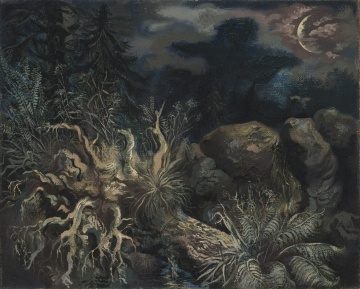
Richard Artschwager, Charles Burchfield, Thomas Hart Benton, Steve DiBenedetto, John Dilg, Walker Evans, Julia Fish, George Grosz, Nate Lowman, Jack Pierson, Ugo Rondinone, Serena Stevens, Joseph Yoakum
The American Landscape
August 26, 2021 - October 2, 2021
Lynda Benglis, Chuck Close, Robert Duran, Ralph Humphrey, Barry Le Va, David Novros, Brice Marden, Paul Mogensen, Deborah Remington, Dorothea Rockburne, Alan Saret, Richard Van Buren, Joe Zucker
13 Artists: A Tribute to Klaus Kertess' Bykert Gallery, 1966-75
June 3, 2021 - July 30, 2021
David Nolan Gallery is delighted to present 13 Artists: A Tribute to Klaus Kertess’ Bykert Gallery 1966-75. The exhibition includes work by Lynda Benglis, Chuck Close, Robert Duran, Ralph Humphrey, Barry Le Va, Brice Marden, Paul Mogensen, David Novros, Deborah Remington, Dorothea Rockburne, Alan Saret, Richard Van Buren and Joe Zucker. David Nolan Gallery currently occupies the same building as the indelible Bykert Gallery once did, where the spirit of an artist-centric, exhibition-forward space continue to guide the program.
Mel Kendrick, David Hartt and Wardell Milan
April 15, 2021 - May 29, 2021
David Nolan Gallery is pleased to present an exhibition of new and recent works by Mel Kendrick, David Hartt and Wardell Milan. The presentation augments and creates a dialogue between current and forthcoming institutional exhibitions by the artists: a career-spanning traveling survey of Mel Kendrick’s work is currently on view at the Addison Museum of American Art in Andover, MA; Hartt’s work is included in the landmark exhibition Reconstructions: Architecture and Blackness in America at the Museum of Modern Art, NY, and is the subject of a solo exhibition at the Glass House, New Canaan, CT; and Wardell Milan will be the subject of his first museum solo exhibition at the Bronx Museum, opening in June 2021.
Jonathan Meese
ACROSS THE UNIVERSE (DR. SPACE-ANIMALISM ,,E.A.G.L.E.": FLY LIKE AN EAGLE)
February 4, 2021 - March 27, 2021
New paintings, sculptures and works on paper

Brígida Baltar, Monica Bonvicini, Chakaia Booker, Hana Miletić, Gabriela Salazar
As Above, So Below
December 1, 2020 - January 31, 2021
David Nolan Gallery is pleased to present "As Above, So Below,” a group exhibition featuring Brígida Baltar, Monica Bonvicini, Chakaia Booker, Hana Miletić, and Gabriela Salazar. The exhibition gathers five international artists active across disparate media and disciplines, united in their unwavering commitment to materials and paradoxical potential for transformation and regeneration.
Barry Le Va
October 9, 2020 - November 20, 2020
Widely recognized as a leading figure of Postminimalism alongside peers Bruce Nauman, Dorothea Rockburne, Richard Serra, and Robert Smithson, among others, Barry Le Va’s influential and elusive practice emerged in the mid-to-late 1960’s in stark contrast to the monolithic, geometrically rigid, and stagnant sculpture of the time, instead championed transience and impermanence, and favored soft, humble materials, twisted and clustered, and deeply invested in physics, psychology, and architecture.
Le Va’s sculptural works are generally the result of an active process of distributing, spilling, scattering, blowing, layering, dropping, and throwing. The distribution of materials allows them to unfold in situ, in sequence and in relation to other conditions, over time. Le Va’s dispersals ultimately push the notion of sculpture to its formal limits: "To eliminate sculpture as a finished, totally resolved object. To eliminate a sense of wholeness and concentrate on parts, fragments, incomplete activities and structures. To emphasize transitional stages of an activity or many activities with no foreseen end…I had to eliminate a contained mass – expand it, extend it…Real time, real space, real locations, real reasons.”
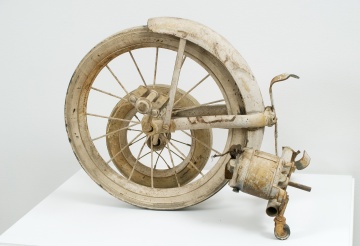
Group exhibition
Duchamp Threads the Needle
February 6, 2020 - March 14, 2020
Rita Ackermann, Robert Arneson, Mike Bidlo, Theaster Gates, Liam Gillick, Kim Jones, Juul Kraijer, Michael Landy, Sherrie Levine, Andrew Mania, Christian Marclay, Robert Morris, Richard Pettibone, Analia Saban, Michael St. John, Jean Tinguely, Mark Wallinger, Robert Watts, and Andrea Zittel.

Wardell Milan
A Project by Wardell Milan: The Balcony
February 6, 2020 - March 14, 2020
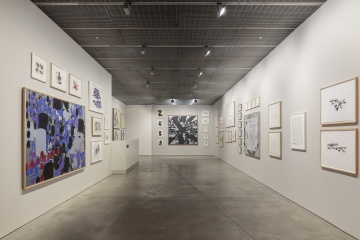
Barry Le Va
Barry Le Va: Part One. Drawings 1967 - 2017
November 14, 2019 - February 1, 2020
David Nolan Gallery is pleased to present Barry Le Va: Part One. Drawings 1967-2017, a survey of works on paper spanning 50 years, on view through February 1, 2020. This is Le Va’s thirteenth solo exhibition at the gallery. Part Two: Sculpture will open in the spring of 2020.
Barry Le Va (b. 1941, Long Beach, California) is regarded as one of the leading figures of Postminimalism and Process Art, and is recognized alongside peers Bruce Nauman, Dorothea Rockburne, Richard Serra, and Robert Smithson. Since the beginning of Le Va’s career in the 1960s he has consistently defied the traditional concept of sculpture as a contained stagnant form, instead championing chance and impermanence, and continuously responding to the environment around him. In Part One, we will present five decades of ceaseless innovation highlighting drawing as an equal half of Le Va’s artistic practice.
Wars: 20th and 21st Centuries
September 12, 2019 - November 2, 2019
And What About Photography?
June 20, 2019 - August 2, 2019
Wardell Milan
Parisian Landscapes, Blue Zenith
April 19, 2019 - June 1, 2019
The Eighties
February 28, 2019 - April 13, 2019
Richard Artschwager
Self-Portraits and the American Southwest
January 10, 2019 - February 23, 2019
Darboven, Le Va, Rockburne, Sandback, Saret, Sonnier
Drawing Space: 1970-1983
November 1, 2018 - December 21, 2018
Ian Hamilton Finlay
"The garden became my study"
September 13, 2018 - October 27, 2018
Parentheses: University of Pennsylvania MFA exhibition curated by David Hartt and Sharon Hayes
June 28, 2018 - July 26, 2018
Jorinde Voigt
Integral
May 4, 2018 - June 23, 2018

 Back to all Member Galleries
Back to all Member Galleries

